

A Summary and Analysis of Martin Luther King’s ‘I Have a Dream’ Speech
By Dr Oliver Tearle (Loughborough University)
‘I Have a Dream’ is one of the greatest speeches in American history. Delivered by Martin Luther King, Jr. (1929-68) in Washington D.C. in 1963, the speech is a powerful rallying cry for racial equality and for a fairer and equal world in which African Americans will be as free as white Americans.
If you’ve ever stayed up till the small hours working on a presentation you’re due to give the next day, tearing your hair out as you try to find the right words, you can take solace in the fact that as great an orator as Martin Luther King did the same with one of the most memorable speeches ever delivered.
He reportedly stayed up until 4am the night before he was due to give his ‘I Have a Dream’, writing it out in longhand. You can read the speech in full here .
‘I Have a Dream’: background
The occasion for King’s speech was the march on Washington , which saw some 210,000 African American men, women, and children gather at the Washington Monument in August 1963, before marching to the Lincoln Memorial.
They were marching for several reasons, including jobs (many of them were out of work), but the main reason was freedom: King and many other Civil Rights leaders sought to remove segregation of black and white Americans and to ensure black Americans were treated the same as white Americans.
1963 was the centenary of the Emancipation Proclamation , in which then US President Abraham Lincoln (1809-65) had freed the African slaves in the United States in 1863. But a century on from the abolition of slavery, King points out, black Americans still are not free in many respects.
‘I Have a Dream’: summary
King begins his speech by reminding his audience that it’s a century, or ‘five score years’, since that ‘great American’ Abraham Lincoln signed the Emancipation Proclamation. This ensured the freedom of the African slaves, but Black Americans are still not free, King points out, because of racial segregation and discrimination.
America is a wealthy country, and yet many Black Americans live in poverty. It is as if the Black American is an exile in his own land. King likens the gathering in Washington to cashing a cheque: in other words, claiming money that is due to be paid.
Next, King praises the ‘magnificent words’ of the US Constitution and the Declaration of Independence . King compares these documents to a promissory note, because they contain the promise that all men, including Black men, will be guaranteed what the Declaration of Independence calls ‘inalienable rights’: namely, ‘life, liberty and the pursuit of happiness’.
King asserts that America in the 1960s has ‘defaulted’ on this promissory note: in other words, it has refused to pay up. King calls it a ‘sacred obligation’, but America as a nation is like someone who has written someone else a cheque that has bounced and the money owed remains to be paid. But it is not because the money isn’t there: America, being a land of opportunity, has enough ‘funds’ to ensure everyone is prosperous enough.
King urges America to rise out of the ‘valley’ of segregation to the ‘sunlit path of racial justice’. He uses the word ‘brotherhood’ to refer to all Americans, since all men and women are God’s children. He also repeatedly emphasises the urgency of the moment. This is not some brief moment of anger but a necessary new start for America. However, King cautions his audience not to give way to bitterness and hatred, but to fight for justice in the right manner, with dignity and discipline.
Physical violence and militancy are to be avoided. King recognises that many white Americans who are also poor and marginalised feel a kinship with the Civil Rights movement, so all Americans should join together in the cause. Police brutality against Black Americans must be eradicated, as must racial discrimination in hotels and restaurants. States which forbid Black Americans from voting must change their laws.
Martin Luther King then comes to the most famous part of his speech, in which he uses the phrase ‘I have a dream’ to begin successive sentences (a rhetorical device known as anaphora ). King outlines the form that his dream, or ambition or wish for a better America, takes.
His dream, he tells his audience, is ‘deeply rooted’ in the American Dream: that notion that anybody, regardless of their background, can become prosperous and successful in the United States. King once again reminds his listeners of the opening words of the Declaration of Independence: ‘We hold these truths to be self-evident, that all men are created equal.’
In his dream of a better future, King sees the descendants of former Black slaves and the descendants of former slave owners united, sitting and eating together. He has a dream that one day his children will live in a country where they are judged not by the colour of their skin but by the content of their character.
Even in Mississippi and Alabama, states which are riven by racial injustice and hatred, people of all races will live together in harmony. King then broadens his dream out into ‘our hope’: a collective aspiration and endeavour. King then quotes the patriotic American song ‘ My Country, ’Tis of Thee ’, which describes America as a ‘sweet land of liberty’.
King uses anaphora again, repeating the phrase ‘let freedom ring’ several times in succession to suggest how jubilant America will be on the day that such freedoms are ensured. And when this happens, Americans will be able to join together and be closer to the day when they can sing a traditional African-American hymn : ‘Free at last. Free at last. Thank God almighty, we are free at last.’
‘I Have a Dream’: analysis
Although Martin Luther King’s speech has become known by the repeated four-word phrase ‘I Have a Dream’, which emphasises the personal nature of his vision, his speech is actually about a collective dream for a better and more equal America which is not only shared by many Black Americans but by anyone who identifies with their fight against racial injustice, segregation, and discrimination.
Nevertheless, in working from ‘I have a dream’ to a different four-word phrase, ‘this is our hope’. The shift is natural and yet it is a rhetorical masterstroke, since the vision of a better nation which King has set out as a very personal, sincere dream is thus telescoped into a universal and collective struggle for freedom.
What’s more, in moving from ‘dream’ to a different noun, ‘hope’, King suggests that what might be dismissed as an idealistic ambition is actually something that is both possible and achievable. No sooner has the dream gathered momentum than it becomes a more concrete ‘hope’.
In his ‘I Have a Dream’ speech, King was doing more than alluding to Abraham Lincoln’s signing of the Emancipation Proclamation one hundred years earlier. The opening words to his speech, ‘Five score years ago’, allude to a specific speech Lincoln himself had made a century before: the Gettysburg Address .
In that speech, delivered at the Soldiers’ National Cemetery (now known as Gettysburg National Cemetery) in Gettysburg, Pennsylvania in November 1863, Lincoln had urged his listeners to continue in the fight for freedom, envisioning the day when all Americans – including Black slaves – would be free. His speech famously begins with the words: ‘Four score and seven years ago our fathers brought forth on this continent, a new nation, conceived in Liberty, and dedicated to the proposition that all men are created equal.’
‘Four score and seven years’ is eighty-seven years, which takes us back from 1863 to 1776, the year of the signing of the Declaration of Independence. So, Martin Luther King’s allusion to the words of Lincoln’s historic speech do two things: they call back to Lincoln’s speech but also, by extension, to the founding of the United States almost two centuries before. Although Lincoln and the American Civil War represented progress in the cause to make all Americans free regardless of their ethnicity, King makes it clear in ‘I Have a Dream’ that there is still some way to go.
In the last analysis, King’s speech is a rhetorically clever and emotionally powerful call to use non-violent protest to oppose racial injustice, segregation, and discrimination, but also to ensure that all Americans are lifted out of poverty and degradation.
But most of all, King emphasises the collective endeavour that is necessary to bring about the world he wants his children to live in: the togetherness, the linking of hands, which is essential to make the dream a reality.
Discover more from Interesting Literature
Subscribe to get the latest posts sent to your email.
Type your email…
Subscribe now to keep reading and get access to the full archive.
Continue reading
- This Day In History
- History Classics
- HISTORY Podcasts
HISTORY Vault
- Link HISTORY on facebook
- Link HISTORY on twitter
- Link HISTORY on youtube
- Link HISTORY on instagram
- Link HISTORY on tiktok
✯ ✯ ✯ Dr. Martin Luther King Jr. ✯ ✯ ✯ His Life and Legacy
Martin Luther King Jr. dedicated his life to the nonviolent struggle for civil rights in the United States. King's leadership played a pivotal role in ending entrenched segregation for African Americans and to the creation of the Civil Rights Act of 1964, considered a crowning achievement of the civil rights era. King was assassinated in 1968, but his words and legacy continue to resonate for all those seeking justice in the United States and around the world. As King said at the Washington National Cathedral on March 31, 1968, "Darkness cannot drive out darkness; only light can do that. Hate cannot drive out hate; only love can do that."
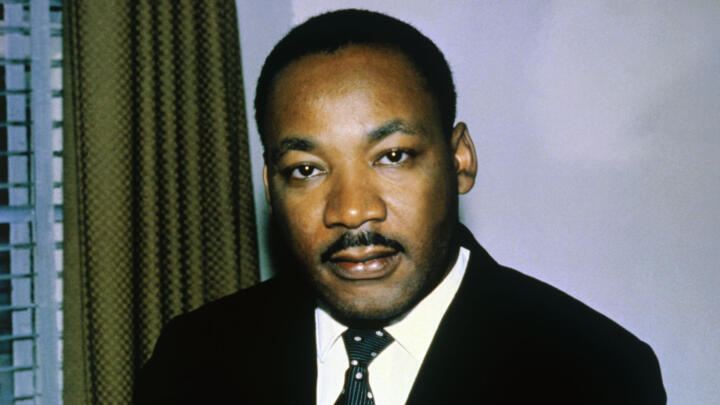
10 Things You May Not Know About Martin Luther King Jr.
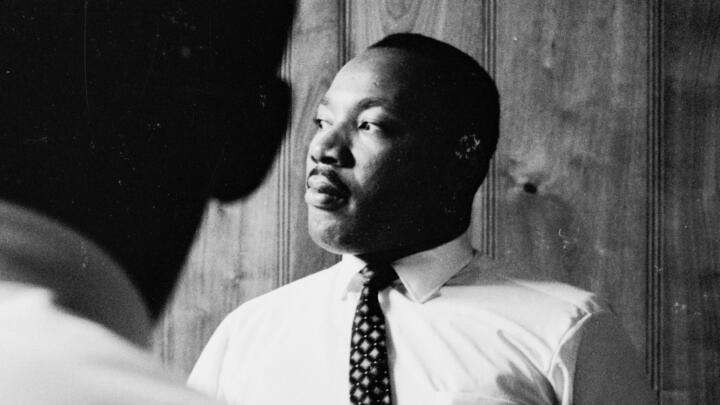
An Intimate View of MLK Through the Lens of a Friend

The Fight for Martin Luther King Jr. Day
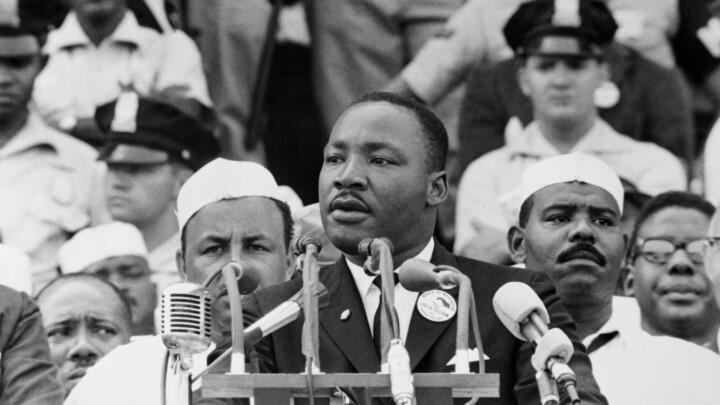
7 of Martin Luther King Jr.'s Most Notable Speeches

Martin Luther King Jr.

7 Things You May Not Know About MLK’s 'I Have a Dream' Speech
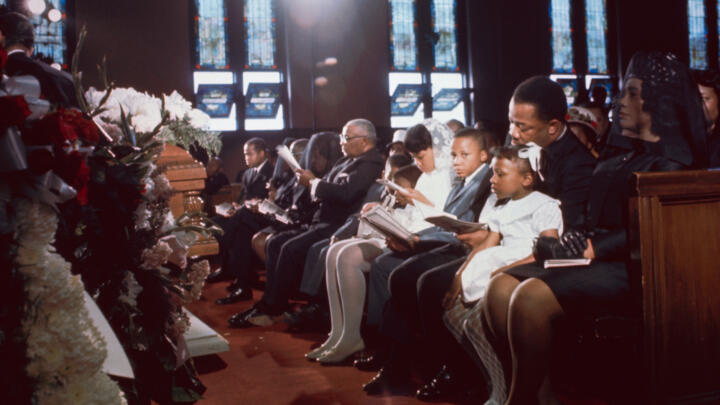
America in Mourning After MLK's Shocking Assassination: Photos

For Martin Luther King Jr., Nonviolent Protest Never Meant ‘Wait and See’
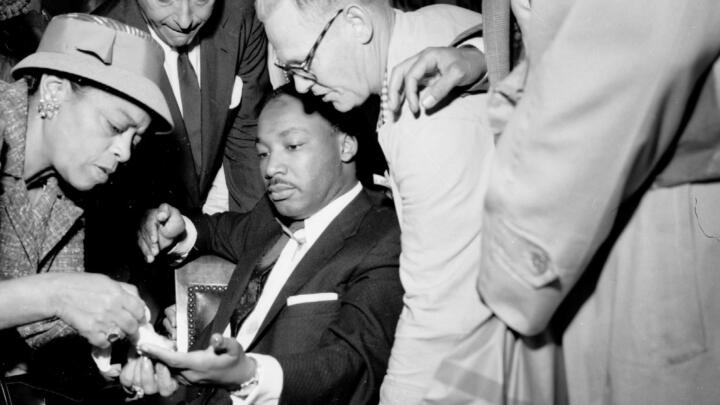
How an Assassination Attempt Affirmed MLK’s Faith in Nonviolence

Jesse Jackson on M.L.K.: One Bullet Couldn’t Kill the Movement
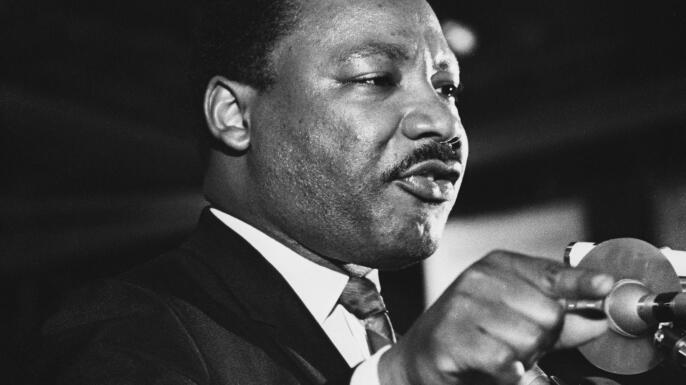
Martin Luther King Jr.’s Final Speech

MLK's Poor People's Campaign Demanded Economic Justice
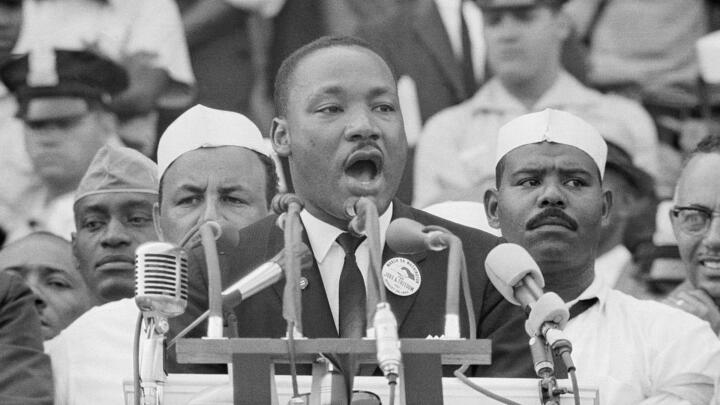
Martin Luther King Jr.’s Famous Speech Almost Didn’t Have the Phrase 'I Have a Dream'

How Selma's 'Bloody Sunday' Became a Turning Point in the Civil Rights Movement
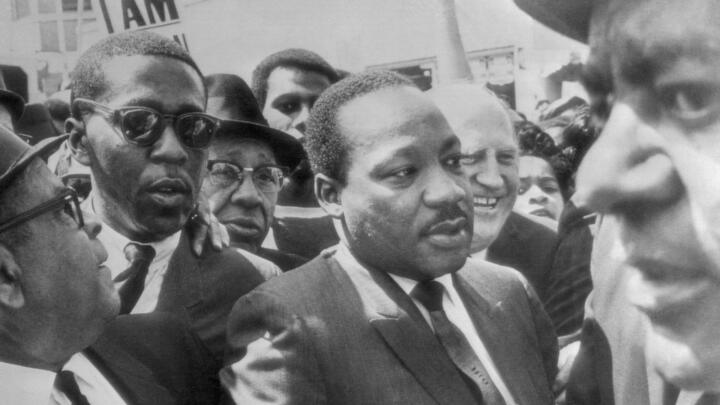
Playlist: Dr. Martin Luther King Jr.
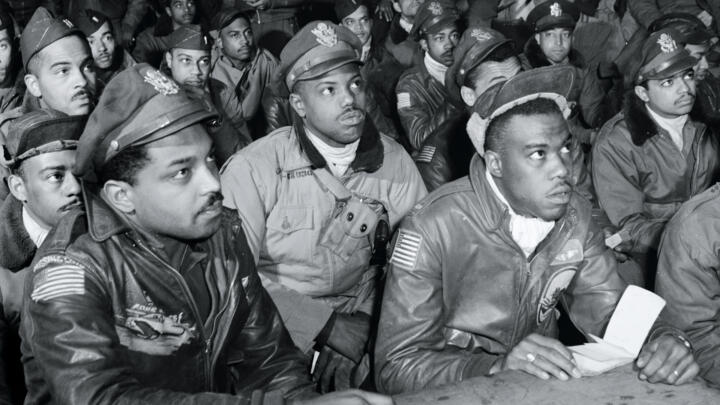
Watch the Black History collection on HISTORY Vault to look back on the history of African American achievements.
Get instant access to free updates.
Don’t Miss Out on HISTORY news, behind the scenes content, and more.
- Privacy Notice
- Terms of Use
Need help with the site?
Create a profile to add this show to your list.
Martin Luther King Jr.
Martin Luther King Jr. was a Baptist minister and major leader of the Civil Rights Movement. After his assassination, he was memorialized by Martin Luther King Jr. Day.

We may earn commission from links on this page, but we only recommend products we back.
In Focus: Martin Luther King Jr. Day
This year’s Martin Luther King Jr. Day, on January 15, coincides with the late civil rights leader ’s birthday. Had he lived, King would be turning 95 years old.
Days after his 1968 assassination , a campaign for a holiday in King’s honor began. U.S. Representative John Conyers Jr. of Michigan first proposed a bill on April 8, 1968, but the first vote on the legislation didn’t happen until 1979. King’s widow, Coretta Scott King , led the lobbying effort to drum up public support. Fifteen years after its introduction, the bill finally became law.
In 1983, President Ronald Reagan ’s signature created Martin Luther King Jr. Day of Service as a federal holiday. It’s celebrated annually on the third Monday in January. The only national day of service, Martin Luther King Jr. Day was first celebrated in 1986. The first time all 50 states recognized the holiday was in 2000.
See Martin Luther King Jr.’s life depicted onscreen in the 2018 documentary I Am MLK Jr. or the Oscar-winning movie Selma .
Who Was Martin Luther King Jr?
Quick facts, where did martin luther king jr. go to school, philosophy of nonviolence, civil rights accomplishments, "i have a dream" and other famous speeches, wife and kids, fbi surveillance, later activism, assassination.
Martin Luther King Jr. was a Baptist minister and civil rights activist who had a seismic impact on race relations in the United States, beginning in the mid-1950s. Among his many efforts, King headed the Southern Christian Leadership Conference (SCLC). Through his nonviolent activism and inspirational speeches , he played a pivotal role in ending legal segregation of Black Americans, as well as the creation of the Civil Rights Act of 1964 and the Voting Rights Act of 1965 . King won the Nobel Peace Prize in 1964, among several other honors. He was assassinated by James Earl Ray and died on April 4, 1968, at age 39. King continues to be remembered as one of the most influential and inspirational Black leaders in history.
FULL NAME: Martin Luther King Jr. BIRTHDAY: January 15, 1929 DIED: April 4, 1968 BIRTHPLACE: Atlanta, Georgia SPOUSE: Coretta Scott King (1953-1968) CHILDREN: Yolanda, Martin III, Dexter, and Bernice King ASTROLOGICAL SIGN: Capricorn
Martin Luther King Jr. was born as Michael Luther King Jr. in Atlanta. His birthday was January 15, 1929.

His parents were Michael Luther King Sr. and Alberta Williams King. The Williams and King families had roots in rural Georgia. Martin’s maternal grandfather, A.D. Williams, was a rural minister for years and then moved to Atlanta in 1893. He took over the small, struggling Ebenezer Baptist Church with around 13 members and made it into a forceful congregation. He married Jennie Celeste Parks, and they had one child who survived, Alberta.
Michael Sr. came from a family of sharecroppers in a poor farming community. He married Alberta in 1926 after an eight-year courtship. The newlyweds moved to A.D.’s home in Atlanta. Michael stepped in as pastor of Ebenezer Baptist Church upon the death of his father-in-law in 1931. He, too, became a successful minister and adopted the name Martin Luther King Sr. in honor of the German Protestant religious leader Martin Luther . In due time, Michael Jr. followed his father’s lead and adopt the name himself to become Martin Luther King Jr.
A middle child, Martin Jr. had an older sister, Willie, and a younger brother, Alfred. The King children grew up in a secure and loving environment. Martin Sr. was more the disciplinarian, while Alberta’s gentleness easily balanced out their father’s strict hand.
Although they undoubtedly tried, Martin Jr.’s parents couldn’t shield him completely from racism. His father fought against racial prejudice, not just because his race suffered, but also because he considered racism and segregation to be an affront to God’s will. He strongly discouraged any sense of class superiority in his children, which left a lasting impression on Martin Jr.
Growing up in Atlanta, King entered public school at age 5. In May 1936, he was baptized, but the event made little impression on him.
In May 1941, King was 12 years old when his grandmother Jennie died of a heart attack. The event was traumatic for the boy, more so because he was out watching a parade against his parents’ wishes when she died. Distraught at the news, young King jumped from a second-story window at the family home, allegedly attempting suicide.
King attended Booker T. Washington High School, where he was said to be a precocious student. He skipped both the ninth and eleventh grades and, at age 15, entered Morehouse College in Atlanta in 1944. He was a popular student, especially with his female classmates, but largely unmotivated, floating through his first two years.
Influenced by his experiences with racism, King began planting the seeds for a future as a social activist early in his time at Morehouse. “I was at the point where I was deeply interested in political matters and social ills,” he recalled in The Autobiography of Martin Luther King, Jr . “I could envision myself playing a part in breaking down the legal barriers to Negro rights.”
The Autobiography of Martin Luther King, Jr.
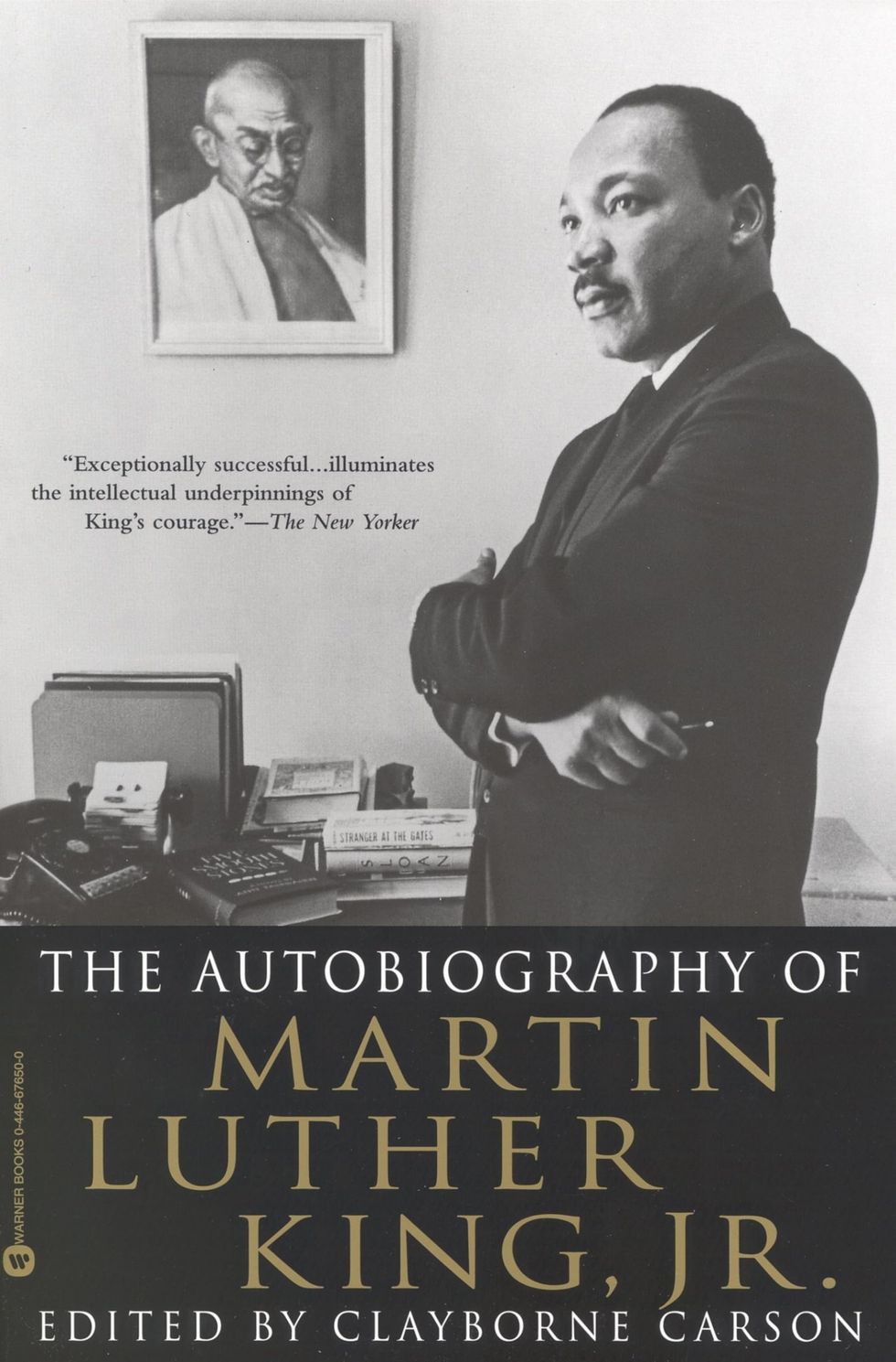
At the time, King felt that the best way to serve that purpose was as a lawyer or a doctor. Although his family was deeply involved in the church and worship, King questioned religion in general and felt uncomfortable with overly emotional displays of religious worship. This discomfort had continued through much of his adolescence, initially leading him to decide against entering the ministry, much to his father’s dismay.
But in his junior year, King took a Bible class, renewed his faith, and began to envision a career in the ministry. In the fall of his senior year, he told his father of his decision, and he was ordained at Ebenezer Baptist Church in February 1948.
Later that year, King earned a sociology degree from Morehouse College and began attended the liberal Crozer Theological Seminary in Chester, Pennsylvania. He thrived in all his studies, was elected student body president, and was valedictorian of his class in 1951. He also earned a fellowship for graduate study.
Even though King was following his father’s footsteps, he rebelled against Martin Sr.’s more conservative influence by drinking beer and playing pool while at college. He became romantically involved with a white woman and went through a difficult time before he could break off the relationship.
During his last year in seminary, King came under the guidance of Morehouse College President Benjamin E. Mays, who influenced King’s spiritual development. Mays was an outspoken advocate for racial equality and encouraged King to view Christianity as a potential force for social change.
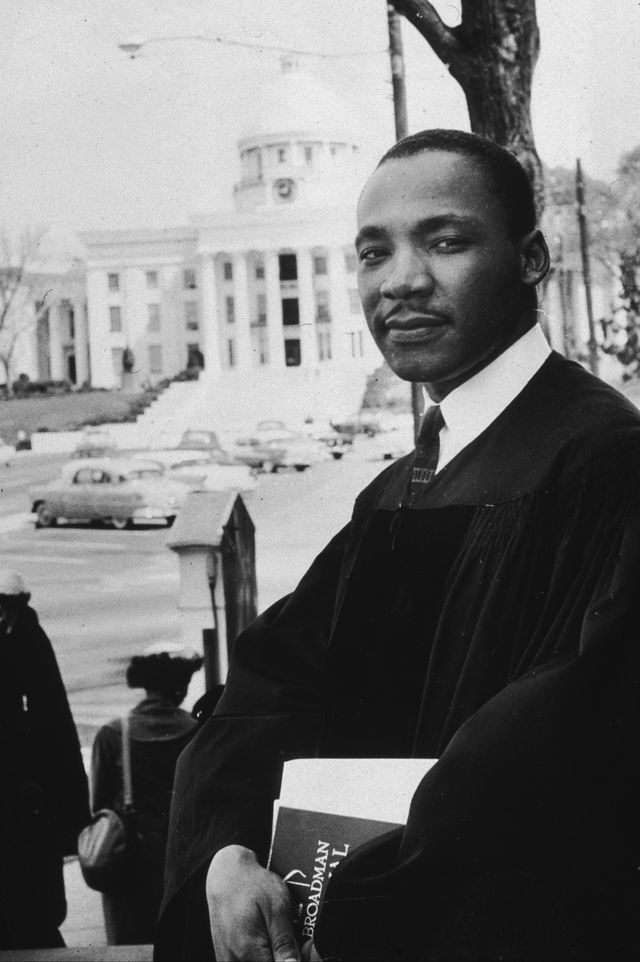
After being accepted at several colleges for his doctoral study, King enrolled at Boston University. In 1954, while still working on his dissertation, King became pastor of the Dexter Avenue Baptist Church of Montgomery, Alabama. He completed his doctorate and earned his degree in 1955 at age 25.
Decades after King’s death, in the late 1980s, researchers at Stanford University’s King Papers Project began to note similarities between passages of King’s doctoral dissertation and those of another student’s work. A committee of scholars appointed by Boston University determined that King was guilty of plagiarism in 1991, though it also recommended against the revocation of his degree.
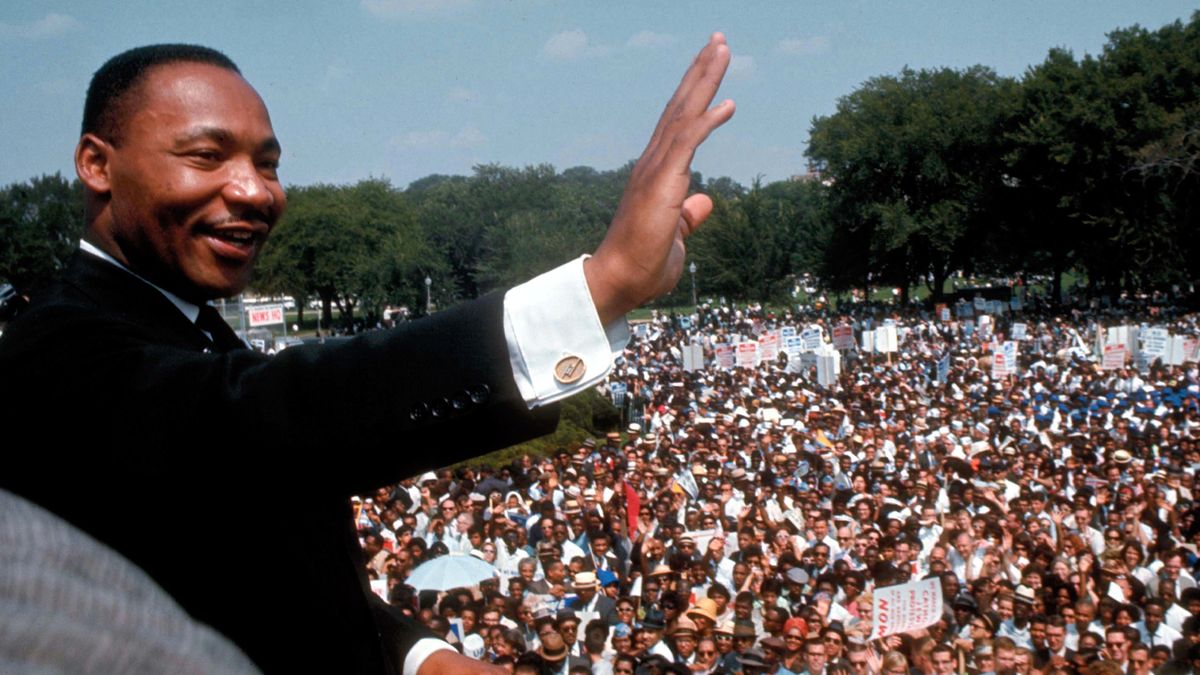
First exposed to the concept of nonviolent resistance while reading Henry David Thoreau ’s On Civil Disobedience at Morehouse, King later discovered a powerful exemplar of the method’s possibilities through his research into the life of Mahatma Gandhi . Fellow civil rights activist Bayard Rustin , who had also studied Gandhi’s teachings, became one of King’s associates in the 1950s and counseled him to dedicate himself to the principles of nonviolence.
As explained in his autobiography , King previously felt that the peaceful teachings of Jesus applied mainly to individual relationships, not large-scale confrontations. But he came to realize: “Love for Gandhi was a potent instrument for social and collective transformation. It was in this Gandhian emphasis on love and nonviolence that I discovered the method for social reform that I had been seeking.”
It led to the formation of King’s six principles of nonviolence :
- Nonviolence is a way of life for courageous people.
- Nonviolence seeks to win friendship and understanding.
- Nonviolence seeks to defeat injustice, not people.
- Nonviolence holds that suffering for a just cause can educate and transform.
- Nonviolence chooses love instead of hate.
- Nonviolence believes that the universe is on the side of justice.
In the years to come, King also frequently cited the “ Beloved Community ”—a world in which a shared spirit of compassion brings an end to the evils of racism, poverty, inequality, and violence—as the end goal of his activist efforts.

Led by his religious convictions and philosophy of nonviolence, King became one of the most prominent figures of the Civil Rights Movement . He was a founding member of the Southern Christian Leadership Conference and played key roles in several major demonstrations that transformed society. This included the Montgomery Bus Boycott that integrated Alabama’s public transit, the Greensboro Sit-In movement that desegregated lunch counters across the South, the March on Washington that led to the passage of the 1964 Civil Rights Act, and the Selma-to-Montgomery marches in Alabama that culminated in the 1965 Voting Rights Act.
King’s efforts earned him the Nobel Peace Prize in 1964 when he was 35.
Montgomery Bus Boycott
King’s first leadership role within the Civil Rights Movement was during the Montgomery Bus Boycott of 1955–1956. The 381-day protest integrated the Alabama city’s public transit in one of the largest and most successful mass movements against racial segregation in history.
The effort began on December 1, 1955, when 42-year-old Rosa Parks boarded the Cleveland Avenue bus to go home after an exhausting day at work. She sat in the first row of the “colored” section in the middle of the bus. As the bus traveled its route, all the seats in the white section filled up, then several more white passengers boarded the bus.
The bus driver noted that there were several white men standing and demanded that Parks and several other African Americans give up their seats. Three other Black passengers reluctantly gave up their places, but Parks remained seated.
The driver asked her again to give up her seat, and again she refused. Parks was arrested and booked for violating the Montgomery City Code. At her trial a week later, in a 30-minute hearing, Parks was found guilty and fined $10 and assessed $4 court fee.
The local NAACP chapter had been looking to challenge Montgomery’s segregated bus policy and had almost made 15-year-old Claudette Colvin the face of the campaign months earlier. She similarly refused to give up her bus seat to a white man on March 2, 1955, but after organizers learned Colvin was pregnant, they feared it would scandalize the deeply religious Black community and make Colvin, along with the group’s efforts, less credible in the eyes of sympathetic white people. Parks’ experience of discrimination provided another opportunity.
On the night Parks was arrested, E.D. Nixon , head of the local NAACP chapter, met with King and other local civil rights leaders to plan a Montgomery Bus Boycott. King was elected to lead the boycott because he was young, well-trained, and had solid family connections and professional standing. He was also new to the community and had few enemies, so organizers felt he would have strong credibility with the Black community.
In his first speech as the group’s president, King declared:
“We have no alternative but to protest. For many years, we have shown an amazing patience. We have sometimes given our white brothers the feeling that we liked the way we were being treated. But we come here tonight to be saved from that patience that makes us patient with anything less than freedom and justice.”
King’s skillful rhetoric put new energy into the civil rights struggle in Alabama. The Montgomery Bus Boycott began December 5, 1955, and for more than a year, the local Black community walked to work, coordinated ride sharing, and faced harassment, violence, and intimidation. Both King’s and Nixon’s homes were attacked.
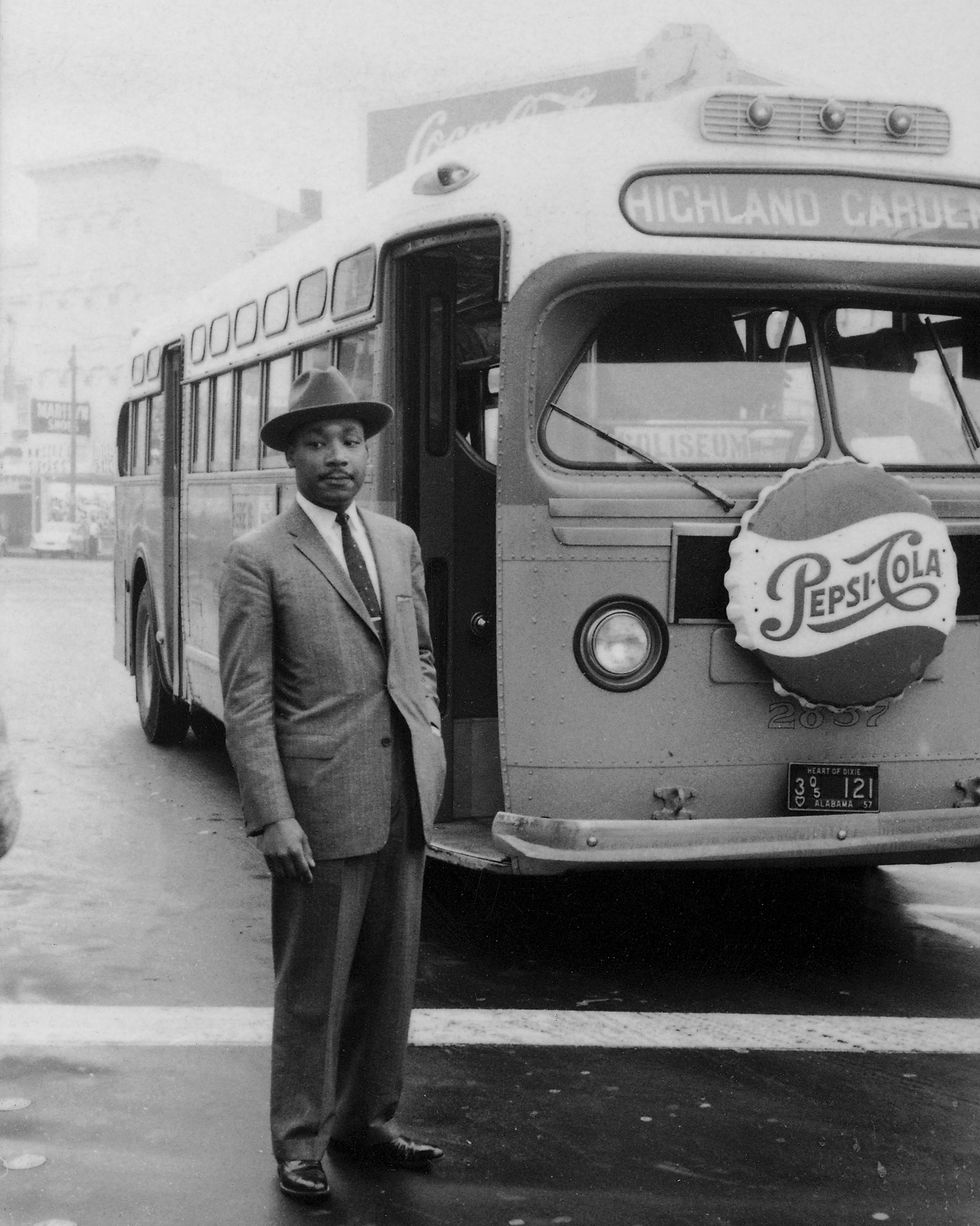
In addition to the boycott, members of the Black community took legal action against the city ordinance that outlined the segregated transit system. They argued it was unconstitutional based on the U.S. Supreme Court ’s “separate is never equal” decision in Brown v. Board of Education (1954). Several lower courts agreed, and the nation’s Supreme Court upheld the ruling in a November 13, 1956, decision that also ruled the state of Alabama’s bus segregation laws were unconstitutional.
After the legal defeats and large financial losses, the city of Montgomery lifted the law that mandated segregated public transportation. The boycott ended on December 20, 1956.
Southern Christian Leadership Conference
Flush with victory, African American civil rights leaders recognized the need for a national organization to help coordinate their efforts. In January 1957, King, Ralph Abernathy , and 60 ministers and civil rights activists founded the Southern Christian Leadership Conference to harness the moral authority and organizing power of Black churches. The SCLC helped conduct nonviolent protests to promote civil rights reform.
King’s participation in the organization gave him a base of operation throughout the South, as well as a national platform. The SCLC felt the best place to start to give African Americans a voice was to enfranchise them in the voting process. In February 1958, the SCLC sponsored more than 20 mass meetings in key southern cities to register Black voters. King met with religious and civil rights leaders and lectured all over the country on race-related issues.
Stride Toward Freedom: The Montgomery Story
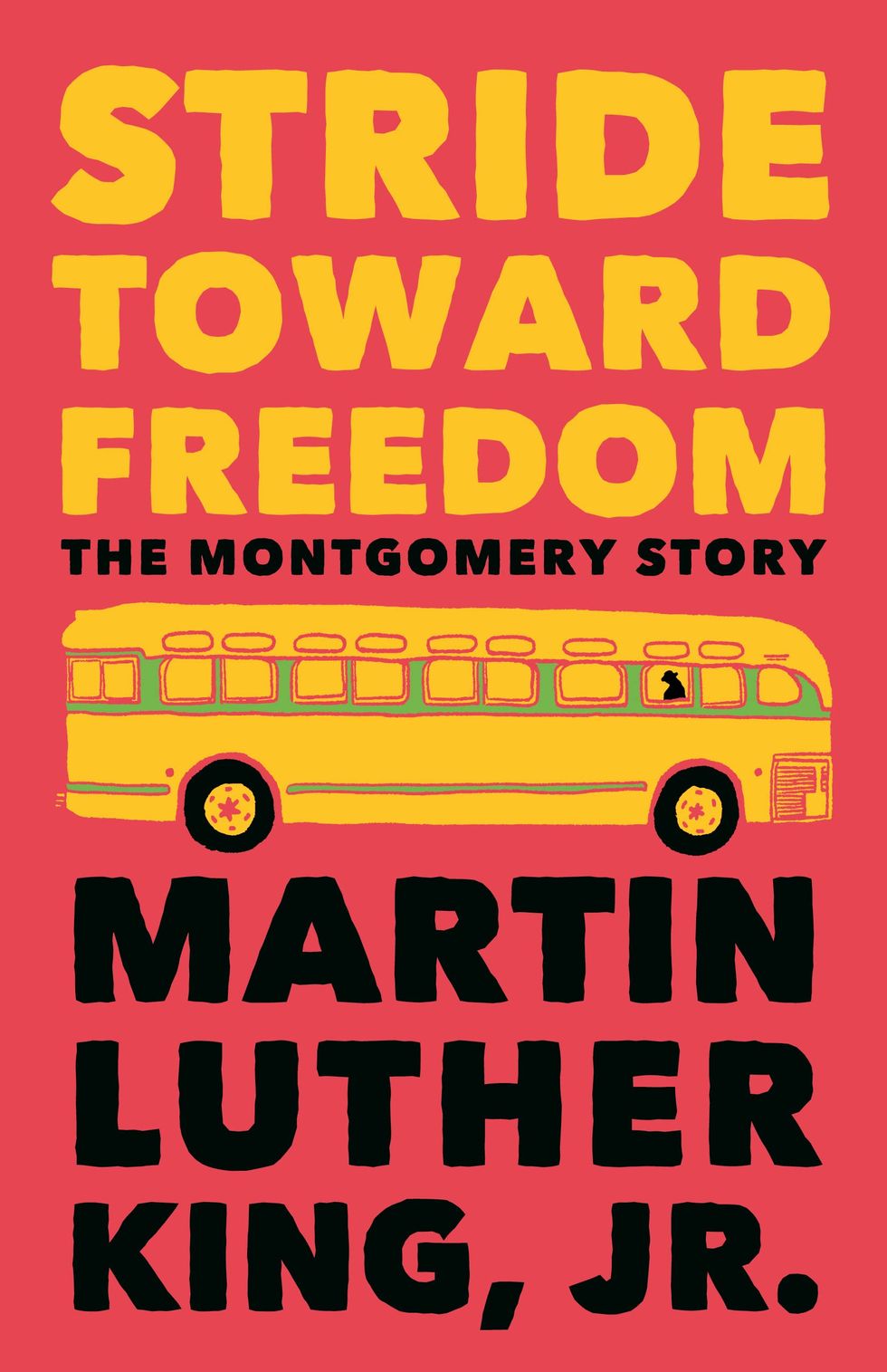
That September, King survived an attempt on his life when a woman with mental illness stabbed him in the chest as he signed copies of his book Stride Toward Freedom in a New York City department store. Saved by quick medical attention, King expressed sympathy for his assailant’s condition in the aftermath .
In 1959, with the help of the American Friends Service Committee, King visited Gandhi ’s birthplace in India. The trip affected him in a profound way, increasing his commitment to America’s civil rights struggle.
Greensboro Sit-In
By 1960, King was gaining national exposure. He returned to Atlanta to become co-pastor with his father at Ebenezer Baptist Church but also continued his civil rights efforts. His next activist campaign was the student-led Greensboro Sit-In movement.
In February 1960, a group of Black students in Greensboro, North Carolina , began sitting at racially segregated lunch counters in the city’s stores. When asked to leave or sit in the “colored” section, they just remained seated, subjecting themselves to verbal and sometimes physical abuse.
The movement quickly gained traction in several other cities. That April, the SCLC held a conference at Shaw University in Raleigh, North Carolina, with local sit-in leaders. King encouraged students to continue to use nonviolent methods during their protests. Out of this meeting, the Student Nonviolent Coordinating Committee (SNCC) formed and, for a time, worked closely with the SCLC. By August 1960, the sit-ins had successfully ended segregation at lunch counters in 27 southern cities. But the movement wasn’t done yet.
On October 19, 1960, King and 75 students entered a local department store and requested lunch-counter service but were denied. When they refused to leave the counter area, King and 36 others were arrested. Realizing the incident would hurt the city’s reputation, Atlanta’s mayor negotiated a truce, and charges were eventually dropped.
Soon after, King was imprisoned for violating his probation on a traffic conviction. The news of his imprisonment entered the 1960 presidential campaign when candidate John F. Kennedy made a phone call to Martin’s wife, Coretta Scott King . Kennedy expressed his concern over the harsh treatment Martin received for the traffic ticket, and political pressure was quickly set in motion. King was soon released.
Letter from Birmingham Jail
In the spring of 1963, King organized a demonstration in downtown Birmingham, Alabama. With entire families in attendance, city police turned dogs and fire hoses on demonstrators. King was jailed, along with large numbers of his supporters.
The event drew nationwide attention. However, King was personally criticized by Black and white clergy alike for taking risks and endangering the children who attended the demonstration.
In his famous Letter from Birmingham Jail , King eloquently spelled out his theory of nonviolence: “Nonviolent direct action seeks to create such a crisis and foster such a tension that a community, which has constantly refused to negotiate, is forced to confront the issue.”
1963 March on Washington
By the end of the Birmingham campaign, King and his supporters were making plans for a massive demonstration on the nation’s capital composed of multiple organizations, all asking for peaceful change. The demonstration was the brainchild of labor leader A. Philip Randolph and King’s one-time mentor Bayard Rustin .
On August 28, 1963, the historic March on Washington for Jobs and Freedom drew an estimated 250,000 people in the shadow of the Lincoln Memorial. It remains one of the largest peaceful demonstrations in American history. During the demonstration, King delivered his famed “I Have a Dream” speech .
The rising tide of civil rights agitation that had culminated in the March on Washington produced a strong effect on public opinion. Many people in cities not experiencing racial tension began to question the nation’s Jim Crow laws and the near-century of second-class treatment of African American citizens since the end of slavery. This resulted in the passage of the Civil Rights Act of 1964 , authorizing the federal government to enforce desegregation of public accommodations and outlawing discrimination in publicly owned facilities.
Selma March
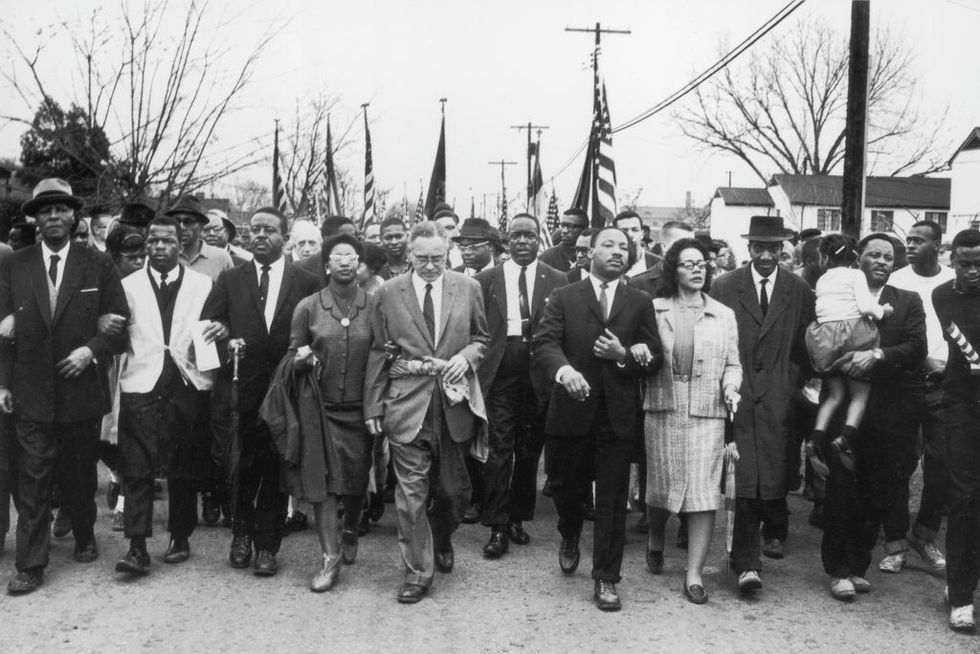
Continuing to focus on voting rights, King, the SCLC, SNCC, and local organizers planned to march peacefully from Selma, Alabama, to the state’s capital, Montgomery.
Led by John Lewis and Hosea Williams , demonstrators set out on March 7, 1965. But the Selma march quickly turned violent as police with nightsticks and tear gas met the demonstrators as they tried to cross the Edmund Pettus Bridge in Selma. The attack was televised, broadcasting the horrifying images of marchers being bloodied and severely injured to a wide audience. Of the 600 demonstrators, 58 were hospitalized in a day that became known as “ Bloody Sunday .” King, however, was spared because he was in Atlanta.
Not to be deterred, activists attempted the Selma-to-Montgomery march again. This time, King made sure he was part of it. Because a federal judge had issued a temporary restraining order on another march, a different approach was taken.
On March 9, 1965, a procession of 2,500 marchers, both Black and white, set out once again to cross the Pettus Bridge and confronted barricades and state troopers. Instead of forcing a confrontation, King led his followers to kneel in prayer, then they turned back. This became known as “Turnaround Tuesday.”
Alabama Governor George Wallace continued to try to prevent another march until President Lyndon B. Johnson pledged his support and ordered U.S. Army troops and the Alabama National Guard to protect the protestors.
On March 21, 1965, approximately 2,000 people began a march from Selma to Montgomery. On March 25, the number of marchers, which had grown to an estimated 25,000 gathered in front of the state capitol where King delivered a televised speech. Five months after the historic peaceful protest, President Johnson signed the 1965 Voting Rights Act .
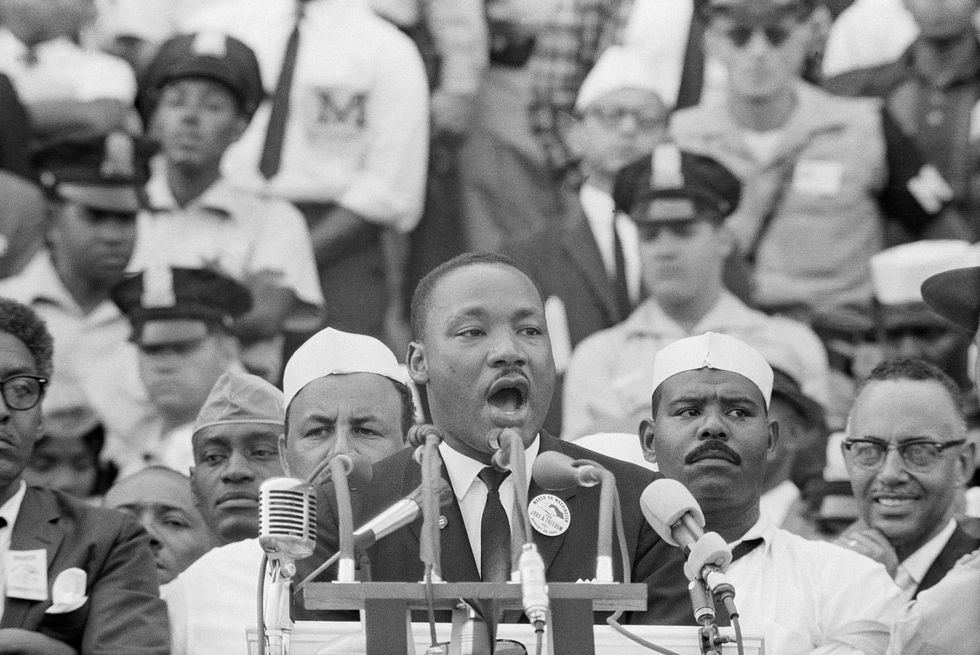
Along with his “I Have a Dream” and “I’ve Been to the Mountaintop” speeches, King delivered several acclaimed addresses over the course of his life in the public eye.
“I Have A Dream” Speech
Date: august 28, 1963.
King gave his famous “I Have a Dream” speech during the 1963 March on Washington. Standing at the Lincoln Memorial, he emphasized his belief that someday all men could be brothers to the 250,000-strong crowd.
Notable Quote: “I have a dream that my four children will one day live in a nation where they will not be judged by the color of their skin but by the content of their character.”
“Give Us the Ballot” Speech
Date: may 17, 1957.
Six years before he told the world of his dream, King stood at the same Lincoln Memorial steps as the final speaker of the Prayer Pilgrimage for Freedom. Dismayed by the ongoing obstacles to registering Black voters, King urged leaders from various backgrounds—Republican and Democrat, Black and white—to work together in the name of justice.
Notable Quote: “Give us the ballot, and we will no longer have to worry the federal government about our basic rights. Give us the ballot, and we will no longer plead to the federal government for passage of an anti-lynching law... Give us the ballot, and we will transform the salient misdeeds of bloodthirsty mobs into the calculated good deeds of orderly citizens.”
Nobel Peace Prize Acceptance Speech
Date: december 10, 1964.
Speaking at the University of Oslo in Norway, King pondered why he was receiving the Nobel Prize when the battle for racial justice was far from over, before acknowledging that it was in recognition of the power of nonviolent resistance. He then compared the foot soldiers of the Civil Rights Movement to the ground crew at an airport who do the unheralded-yet-necessary work to keep planes running on schedule.
Notable Quote: “I think Alfred Nobel would know what I mean when I say that I accept this award in the spirit of a curator of some precious heirloom which he holds in trust for its true owners—all those to whom beauty is truth and truth, beauty—and in whose eyes the beauty of genuine brotherhood and peace is more precious than diamonds or silver or gold.”
“Our God is Marching On (How Long? Not Long)” Speech
Date: march 25, 1965.
At the end of the bitterly fought Selma-to-Montgomery march, King addressed a crowd of 25,000 supporters from the Alabama State Capitol. Offering a brief history lesson on the roots of segregation, King emphasized that there would be no stopping the effort to secure full voting rights, while suggesting a more expansive agenda to come with a call to march on poverty.
Notable Quote: “I come to say to you this afternoon, however difficult the moment, however frustrating the hour, it will not be long, because ‘truth crushed to earth will rise again.’ How long? Not long, because ‘no lie can live forever.’... How long? Not long, because the arc of the moral universe is long, but it bends toward justice.”
“Beyond Vietnam: A Time to Break Silence” Speech
Date: april 4, 1967.
One year before his assassination, King delivered a controversial sermon at New York City’s Riverside Church in which he condemned the Vietnam War. Explaining why his conscience had forced him to speak up, King expressed concern for the poor American soldiers pressed into conflict thousands of miles from home, while pointedly faulting the U.S. government’s role in escalating the war.
Notable Quote: “We still have a choice today: nonviolent coexistence or violent co-annihilation. We must move past indecision to action. We must find new ways to speak for peace in Vietnam and justice throughout the developing world, a world that borders on our doors. If we do not act, we shall surely be dragged down the long, dark, and shameful corridors of time reserved for those who possess power without compassion, might without morality, and strength without sight.”
“I’ve Been to the Mountaintop” Speech
Date: april 3, 1968.
The well-known orator delivered his final speech the day before he died at the Mason Temple in Memphis, Tennessee. King reflected on major moments of progress in history and his own life, in addition to encouraging the city’s striking sanitation workers.
Notable Quote: “I’ve seen the promised land. I may not get there with you. But I want you to know tonight that we, as a people, will get to the promised land.”
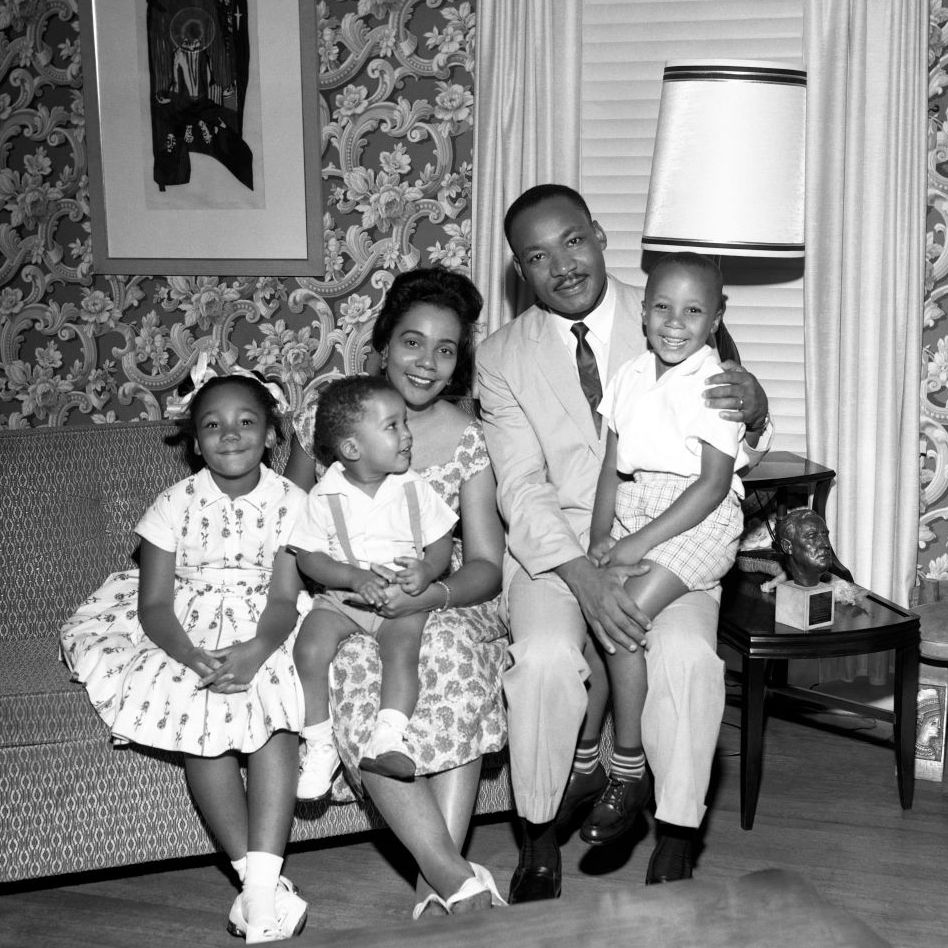
While working on his doctorate at Boston University, King met Coretta Scott , an aspiring singer and musician at the New England Conservatory school in Boston. They were married on June 18, 1953, and had four children—two daughters and two sons—over the next decade. Their oldest, Yolanda, was born in 1955, followed by sons Martin Luther King III in 1957 and Dexter in 1961. The couple welcomed Bernice King in 1963.
Although she accepted the responsibility to raise the children while King travelled the country, Coretta opened their home to organizational meetings and served as an advisor and sounding board for her husband. “I am convinced that if I had not had a wife with the fortitude, strength, and calmness of Corrie, I could not have withstood the ordeals and tensions surrounding the movement,” King wrote in his autobiography.
His lengthy absences became a way of life for their children, but Martin III remembered his father returning from the road to join the kids playing in the yard or bring them to the local YMCA for swimming. King also fostered discussions at mealtimes to make sure everyone understood the important issues he was seeking to resolve.
Leery of accumulating wealth as a high-profile figure, King insisted his family live off his salary as a pastor. However, he was known to splurge on good suits and fine dining, while contrasting his serious public image with a lively sense of humor among friends and family.
Due to his relationships with alleged Communists, King became a target of FBI surveillance and, from late 1963 until his death, a campaign to discredit the civil rights activist. While FBI wiretaps failed to produce evidence of Communist sympathies, they captured the civil rights leader’s engagement in extramarital dalliances. This led to the infamous “suicide letter” of 1964, later confirmed to be from the FBI and authorized by then-Director J. Edgar Hoover , which urged King to kill himself if he wanted to prevent news of his affairs from going public.
In 2019, historian David Garrow wrote of explosive new allegations against King following his review of recently released FBI documents. Among the discoveries was a memo suggesting that King had encouraged the rape of a parishioner in a hotel room, as well as evidence that he might have fathered a daughter with a mistress. Other historians questioned the veracity of the documentation, especially given the FBI’s known attempts to damage King’s reputation. The original surveillance tapes regarding these allegations are under judicial seal until 2027.
From late 1965 through 1967, King expanded his civil rights efforts into other larger American cities, including Chicago and Los Angeles. But he met with increasing criticism and public challenges from young Black power leaders. King’s patient, non-violent approach and appeal to white middle-class citizens alienated many Black militants who considered his methods too weak, too late, and ineffective.
To address this criticism, King began making a link between discrimination and poverty, and he began to speak out against the Vietnam War . He felt America’s involvement in Vietnam was politically untenable and the government’s conduct in the war was discriminatory to the poor. He sought to broaden his base by forming a multiracial coalition to address the economic and unemployment problems of all disadvantaged people. To that end, plans were in the works for another march on Washington to highlight the Poor People’s Campaign, a movement intended to pressure the government into improving living and working conditions for the economically disadvantaged.
By 1968, the years of demonstrations and confrontations were beginning to wear on King. He had grown tired of marches, going to jail, and living under the constant threat of death. He was becoming discouraged at the slow progress of civil rights in America and the increasing criticism from other African American leaders.
In the spring of 1968, a labor strike by Memphis, Tennessee, sanitation workers drew King to one last crusade. On April 3, 1968, he gave his final and what proved to be an eerily prophetic speech, “I’ve Been to the Mountaintop,” in which he told supporters, “Like anybody, I would like to live a long life. Longevity has its place. But I’m not concerned about that now… I’m not worried about anything. I’m not fearing any man. Mine eyes have seen the glory of the coming of the Lord.”
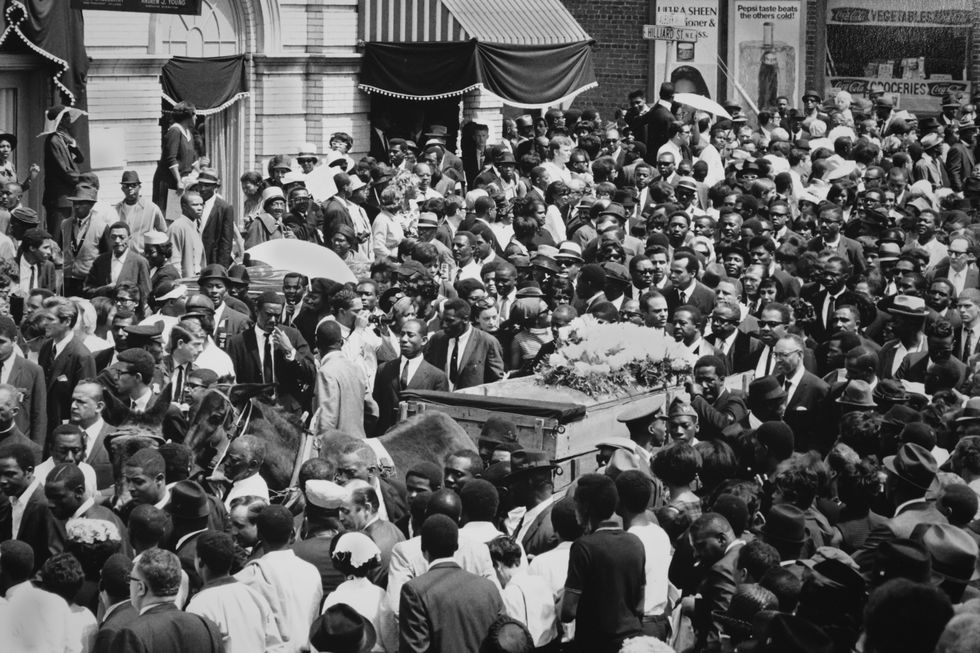
While standing on a balcony outside his room at the Lorraine Motel in Memphis, Tennessee, Martin Luther King Jr. was killed by a sniper’s bullet on April 4, 1968. King died at age 39. The shocking assassination sparked riots and demonstrations in more than 100 cities across the country.
The shooter was James Earl Ray , a malcontent drifter and former convict. He initially escaped authorities but was apprehended after a two-month international manhunt. In 1969, Ray pleaded guilty to assassinating King and was sentenced to 99 years in prison.
The identity of King’s assassin has been the source of some controversy. Ray recanted his confession shortly after he was sentenced, and King’s son Dexter publicly defended Ray’s innocence after meeting with the convicted gunman in 1997. Another complicating factor is the 1993 confession of tavern owner Loyd Jowers, who said he contracted a different hit man to kill King. In June 2000, the U.S. Justice Department released a report that dismissed the alternative theories of King’s death. Ray died in prison on April 23, 1998.
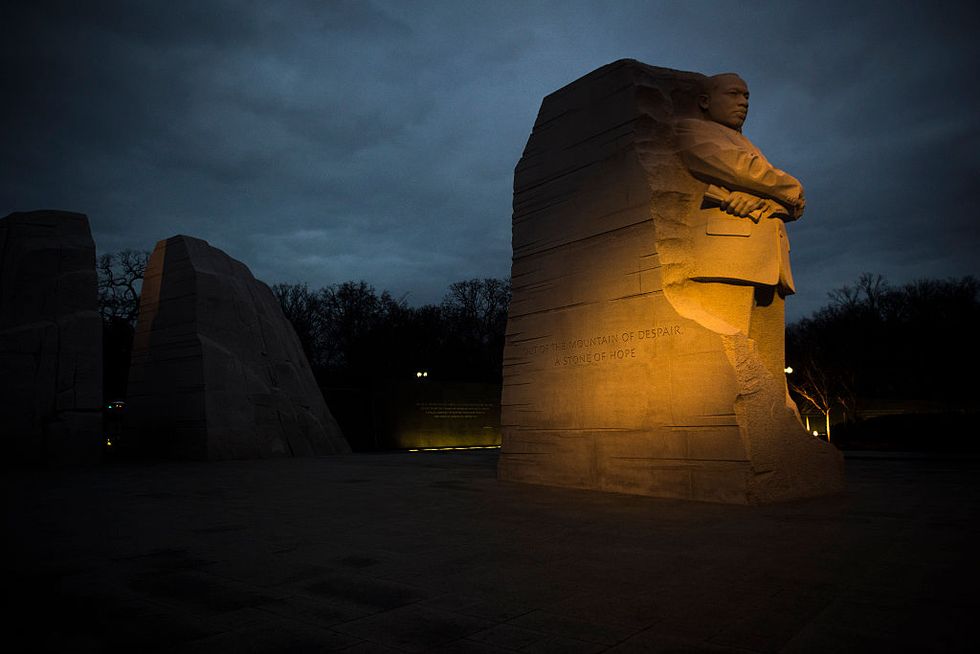
King’s life had a seismic impact on race relations in the United States. Years after his death, he is the most widely known Black leader of his era.
His life and work have been honored with a national holiday, schools and public buildings named after him, and a memorial on Independence Mall in Washington, D.C.
Over the years, extensive archival studies have led to a more balanced and comprehensive assessment of his life, portraying him as a complex figure: flawed, fallible, and limited in his control over the mass movements with which he was associated, yet a visionary leader who was deeply committed to achieving social justice through nonviolent means.
- But we come here tonight to be saved from that patience that makes us patient with anything less than freedom and justice.
- There comes a time when the cup of endurance runs over and men are no longer willing to be plunged into an abyss of injustice where they experience the bleakness of corroding despair.
- Any law that uplifts human personality is just. Any law that degrades human personality is unjust.
- The whirlwinds of revolt will continue to shake the foundations of our nation until the bright day of justice emerges.
- Let us not seek to satisfy our thirst for freedom by drinking from the cup of bitterness and hatred.
- Darkness cannot drive out darkness: only light can do that. Hate cannot drive out hate: only love can do that.
- The ultimate measure of a man is not where he stands in moments of comfort and convenience, but where he stands at times of challenge and controversy. The true neighbor will risk his position, his prestige, and even his life for the welfare of others.
- We must all learn to live together as brothers, or we will all perish together as fools.
- Forgiveness is not an occasional act; it is a permanent attitude.
- I have a dream that my four children will one day live in a nation where they will not be judged by the color of their skin but by the content of their character.
- The function of education, therefore, is to teach one to think intensively and to think critically. But education which stops with efficiency may prove the greatest menace to society. The most dangerous criminal may be the man gifted with reason but with no morals.
- I’ve seen the promised land. I may not get there with you. But I want you to know tonight that we, as a people, will get to the promised land.
- Power at its best is love implementing the demands of justice. Justice at its best is love correcting everything that stands against love.
- A man who won’t die for something is not fit to live.
- At the center of non-violence stands the principle of love.
- Right, temporarily defeated, is stronger than evil triumphant.
- In the end, we will remember not the words of our enemies, but the silence of our friends.
- Injustice anywhere is a threat to justice everywhere.
- Our lives begin to end the day we become silent about things that matter.
Fact Check: We strive for accuracy and fairness. If you see something that doesn’t look right, contact us !
The Biography.com staff is a team of people-obsessed and news-hungry editors with decades of collective experience. We have worked as daily newspaper reporters, major national magazine editors, and as editors-in-chief of regional media publications. Among our ranks are book authors and award-winning journalists. Our staff also works with freelance writers, researchers, and other contributors to produce the smart, compelling profiles and articles you see on our site. To meet the team, visit our About Us page: https://www.biography.com/about/a43602329/about-us
Civil Rights Activists

Ethel Kennedy
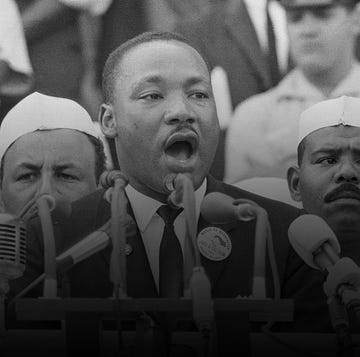
MLK Almost Didn’t Say “I Have a Dream”

Huey P. Newton

Martin Luther King Jr. Didn’t Criticize Malcolm X

5 Crowning Achievements of Maya Angelou
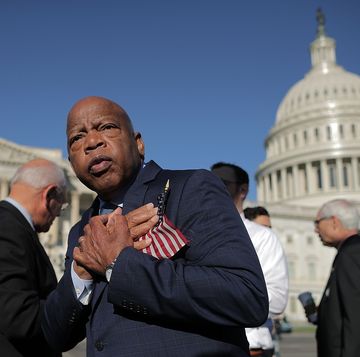
30 Civil Rights Leaders of the Past and Present

Benjamin Banneker
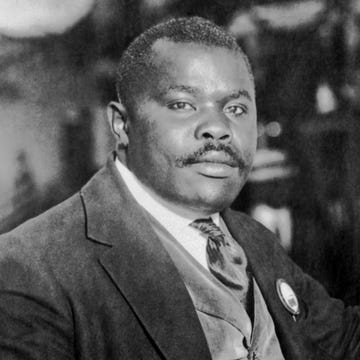
Marcus Garvey

Madam C.J. Walker

Maya Angelou
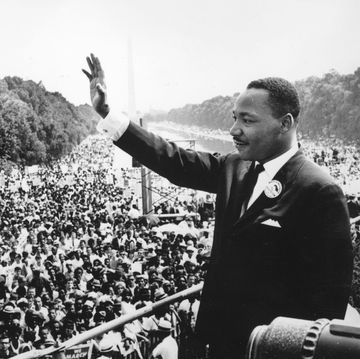
17 Inspiring Martin Luther King Quotes
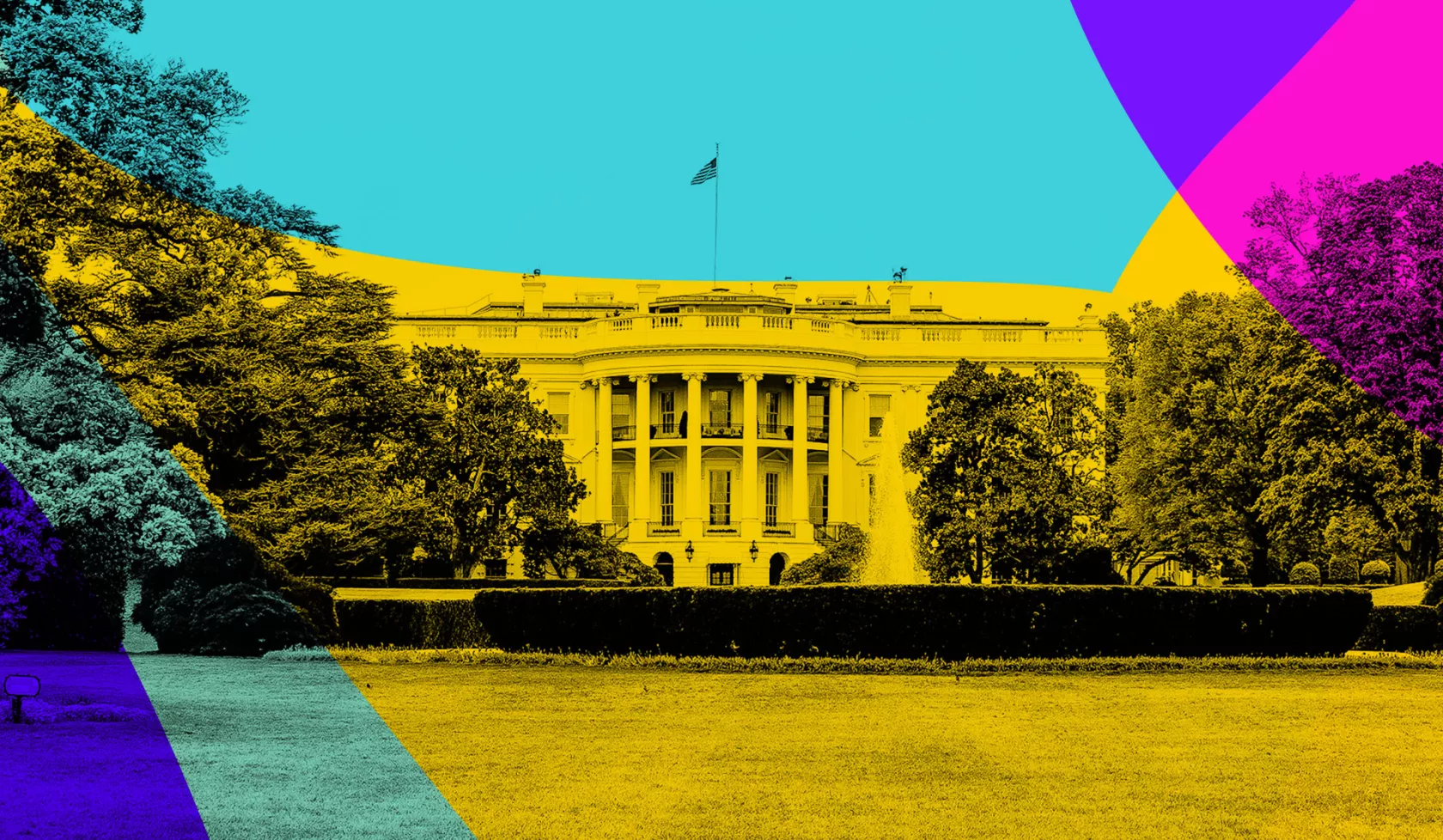
The 1963 March on Washington
A quarter million people and a dream.
On August 28, 1963, more than a quarter million people participated in the historic March on Washington for Jobs and Freedom, gathering near the Lincoln Memorial.
More than 3,000 members of the press covered this historic march, where Rev. Dr. Martin Luther King, Jr. delivered the exalted "I Have a Dream" speech.
Originally conceived by renowned labor leader A. Phillip Randolph and Roy Wilkins, Executive Secretary of the NAACP, the March on Washington evolved into a collaborative effort amongst major civil rights groups and icons of the day.
Stemming from a rapidly growing tide of grassroots support and outrage over the nation's racial inequities, the rally drew over 260,000 people from across the nation.
Celebrated as one of the greatest — if not the greatest — speech of the 20th century, Dr. King's celebrated speech, "I Have a Dream," was carried live by television stations across the country. You can read the full speech and watch a short film, below.
A March 20 Years in the Making
In 1941, A. Phillip Randolph first conceptualized a "march for jobs" in protest of the racial discrimination against African Americans from jobs created by WWII and the New Deal programs created by President Franklin D. Roosevelt.
The march was stalled, however, after negotiations between Roosevelt and Randolph prompted the establishment of the Fair Employment Practice Committee (FEPC) and an executive order banning discrimination in defense industries.
The FEPC dissolved just five years later, causing Randolph to revive his plans. He looked to the charismatic Dr. King to breathe new life into the march.
NAACP and SCLC Center the March on Civil Rights
By the late 1950s, Dr. King and his Southern Christian Leadership Conference (SCLC) were also planning to march on Washington, this time to march for freedom.
As the years passed on, the Civil Rights Act was still stalled in Congress, and equality for Americans of color still seemed like a far-fetched dream.
Randolph, his chief aide, Bayard Rustin, and Dr. King all decided it would be best to combine the two causes into one mega-march, the March for Jobs and Freedom.
NAACP, headed by Roy Wilkins, was called upon to be one of the leaders of the march.
As one of the largest and most influential civil rights groups at the time, our organization harnessed the collective power of its members, organizing a march that was focused on the advancement of civil rights and the actualization of Dr. King's dream.
The Big Six
A quarter-million people strong, the march drew activists from far and wide.
Leaders of the six prominent civil rights groups at the time joined forces in organizing the march.
The group included Randolph, leader of the Brotherhood of Sleeping Car Porters; Wilkins, Executive Secretary of the NAACP; Dr. King, Chairman of the SCLC; James Farmer, founder of the Congress of Racial Equality (CORE); John Lewis, President of the Student Nonviolent Coordinating Committee (SNCC); and Whitney Young, Executive Director of the National Urban League.
Dr. King, originally slated to speak for 4 minutes, went on to speak for 16 minutes, giving one of the most iconic speeches in history.
"I have a dream that one day on the red hills of Georgia, the sons of former slaves and the sons of former slave owners will be able to sit down together at a table of brotherhood." – I Have a Dream, Rev. Dr. Martin Luther King, Jr.
It didn't take long for King's dream to come to fruition — the legislative aspect of the dream, that is.
After a decade of continued lobbying of Congress and the President led by the NAACP, plus other peaceful protests for civil rights, President Lyndon Johnson signed into law the Civil Rights Act of 1964.
One year later, he signed the National Voting Rights Act of 1965 .
Together, these laws outlawed discrimination against blacks and women, effectively ending segregation, and sought to end disenfranchisement by making discriminatory voting practices illegal.
Ten years after King joined the civil rights fight, the campaign to secure the enactment of the 1964 Civil Rights Act had achieved its goal – to ensure that black citizens would have the power to represent themselves in government.

2020 March on Washington

Rev. Dr. Martin Luther King, Jr., delivered this iconic 'I Have a Dream' speech at the March on Washington on August 28, 1963. See entire text of King's speech below.
I Have a Dream
I am happy to join with you today in what will go down in history as the greatest demonstration for freedom in the history of our nation.
Five score years ago, a great American, in whose symbolic shadow we stand today, signed the Emancipation Proclamation. This momentous decree came as a great beacon light of hope to millions of Negro slaves who had been seared in the flames of withering injustice. It came as a joyous daybreak to end the long night of their captivity.
But one hundred years later, the Negro still is not free; one hundred years later, the life of the Negro is still sadly crippled by the manacles of segregation and the chains of discrimination; one hundred years later, the Negro lives on a lonely island of poverty in the midst of a vast ocean of material prosperity; one hundred years later, the Negro is still languished in the corners of American society and finds himself in exile in his own land.
So we've come here today to dramatize a shameful condition. In a sense we've come to our nation's capital to cash a check. When the architects of our republic wrote the magnificent words of the Constitution and the Declaration of Independence, they were signing a promissory note to which every American was to fall heir. This note was the promise that all men, yes, black men as well as white men, would be guaranteed the unalienable rights of life, liberty, and the pursuit of happiness.
It is obvious today that America has defaulted on this promissory note in so far as her citizens of color are concerned. Instead of honoring this sacred obligation, America has given the Negro people a bad check, a check which has come back marked "insufficient funds."
But we refuse to believe that the bank of justice is bankrupt. We refuse to believe that there are insufficient funds in the great vaults of opportunity of this nation. And so we have come to cash this check, a check that will give us upon demand the riches of freedom and the security of justice.
We have also come to this hallowed spot to remind America of the fierce urgency of now.
This is no time to engage in the luxury of cooling off or to take the tranquilizing drug of gradualism.
Now is the time to make real the promises of democracy; now is the time to rise from the dark and desolate valley of segregation to the sunlit path of racial justice; now is the time to lift our nation from the quicksands of racial injustice to the solid rock of brotherhood; now is the time to make justice a reality for all of God's children.
It would be fatal for the nation to overlook the urgency of the moment.
This sweltering summer of the Negro's legitimate discontent will not pass until there is an invigorating autumn of freedom and equality. Nineteen sixty-three is not an end, but a beginning. And those who hope that the Negro needed to blow off steam and will now be content, will have a rude awakening if the nation returns to business as usual. There will be neither rest nor tranquility in America until the Negro is granted his citizenship rights. The whirlwinds of revolt will continue to shake the foundations of our nation until the bright day of justice emerges.
But there is something that I must say to my people, who stand on the worn threshold which leads into the palace of justice. In the process of gaining our rightful place, we must not be guilty of wrongful deeds. Let us not seek to satisfy our thirst for freedom by drinking from the cup of bitterness and hatred.
We must forever conduct our struggle on the high plane of dignity and discipline. We must not allow our creative protests to degenerate into physical violence. Again and again we must rise to the majestic heights of meeting physical force with soul force. The marvelous new militancy, which has engulfed the Negro community, must not lead us to a distrust of all white people. For many of our white brothers, as evidenced by their presence here today, have come to realize that their destiny is tied up with our destiny. And they have come to realize that their freedom is inextricably bound to our freedom.
We cannot walk alone. And as we walk, we must make the pledge that we shall always march ahead. We cannot turn back.
There are those who are asking the devotees of Civil Rights, "When will you be satisfied?"
We can never be satisfied as long as the Negro is the victim of the unspeakable horrors of police brutality; we can never be satisfied as long as our bodies, heavy with the fatigue of travel, cannot gain lodging in the motels of the highways and the hotels of the cities; we cannot be satisfied as long as the Negro's basic mobility is from a smaller ghetto to a larger one; we can never be satisfied as long as our children are stripped of their selfhood and robbed of their dignity by signs stating "For Whites Only"; we cannot be satisfied as long as the Negro in Mississippi cannot vote, and the Negro in New York believes he has nothing for which to vote.
No! no, we are not satisfied, and we will not be satisfied until "justice rolls down like waters and righteousness like a mighty stream."
I am not unmindful that some of you have come here out of great trials and tribulations. Some of you have come fresh from narrow jail cells. Some of you have come from areas where your quest for freedom left you battered by the storms of persecution and staggered by the winds of police brutality.
You have been the veterans of creative suffering.
Continue to work with the faith that unearned suffering is redemptive.
Go back to Mississippi. Go back to Alabama. Go back to South Carolina. Go back to Georgia. Go back to Louisiana. Go back to the slums and ghettos of our Northern cities, knowing that somehow this situation can and will be changed. Let us not wallow in the valley of despair.
I say to you today, my friends, so even though we face the difficulties of today and tomorrow, I still have a dream.
It is a dream deeply rooted in the American dream.
I have a dream that one day this nation will rise up and live out the true meaning of its creed, "We hold these truths to be self-evident, that all men are created equal."
I have a dream that one day on the red hills of Georgia, sons of former slaves and the sons of former slaveowners will be able to sit down together at the table of brotherhood.
I have a dream that one day even the state of Mississippi, a state sweltering with the heat of injustice, sweltering with the heat of oppression, will be transformed into an oasis of freedom and justice.
I have a dream that my four little children will one day live in a nation where they will not be judged by the color of their skin but by the content of their character.
I have a dream today!
I have a dream that one day down in Alabama — with its vicious racists, with its Governor having his lips dripping with the words of interposition and nullification — one day right there in Alabama, little black boys and black girls will be able to join hands with little white boys and white girls as sisters and brothers.
I have a dream that one day every valley shall be exalted, and every hill and mountain shall be made low. The rough places will be plain and the crooked places will be made straight, "and the glory of the Lord shall be revealed, and all flesh shall see it together."
This is our hope. This is the faith that I go back to the South with. With this faith we will be able to hew out of the mountain of despair a stone of hope.
With this faith we will be able to transform the jangling discords of our nation into a beautiful symphony of brother-hood. With this faith we will be able to work together, to pray together, to struggle together, to go to jail together, to stand up for freedom together, knowing that we will be free one day.
And this will be the day.
This will be the day when all of God's children will be able to sing with new meaning, "My country 'tis of thee, sweet land of liberty, of thee I sing. Land where my father died, land of the pilgrim's pride, from every mountainside, let freedom ring." And if America is to be a great nation, this must become true.
So let freedom ring from the prodigious hilltops of New Hampshire; let freedom ring from the mighty mountains of New York; let freedom ring from the heightening Alleghenies of Pennsylvania; let freedom ring from the snow-capped Rockies of Colorado; let freedom ring from the curvaceous slopes of California.
But not only that.
Let freedom ring from Stone Mountain of Georgia; let freedom ring from Lookout Mountain of Tennessee; let freedom ring from every hill and mole hill of Mississippi. "From every mountainside, let freedom ring."
And when this happens, and when we allow freedom to ring, when we let it ring from every village and every hamlet, from every state and every city, we will be able to speed up that day when all of God's children, black men and white men, Jews and Gentiles, Protestants and Catholics, will be able to join hands and sing in the words of the old Negro spiritual:
"Free at last. Free at last. Thank God Almighty, we are free at last."
Source: Martin Luther King, Jr., I Have A Dream: Writings and Speeches that Changed the World (San Francisco: Harper, 1986) via Teaching America History.
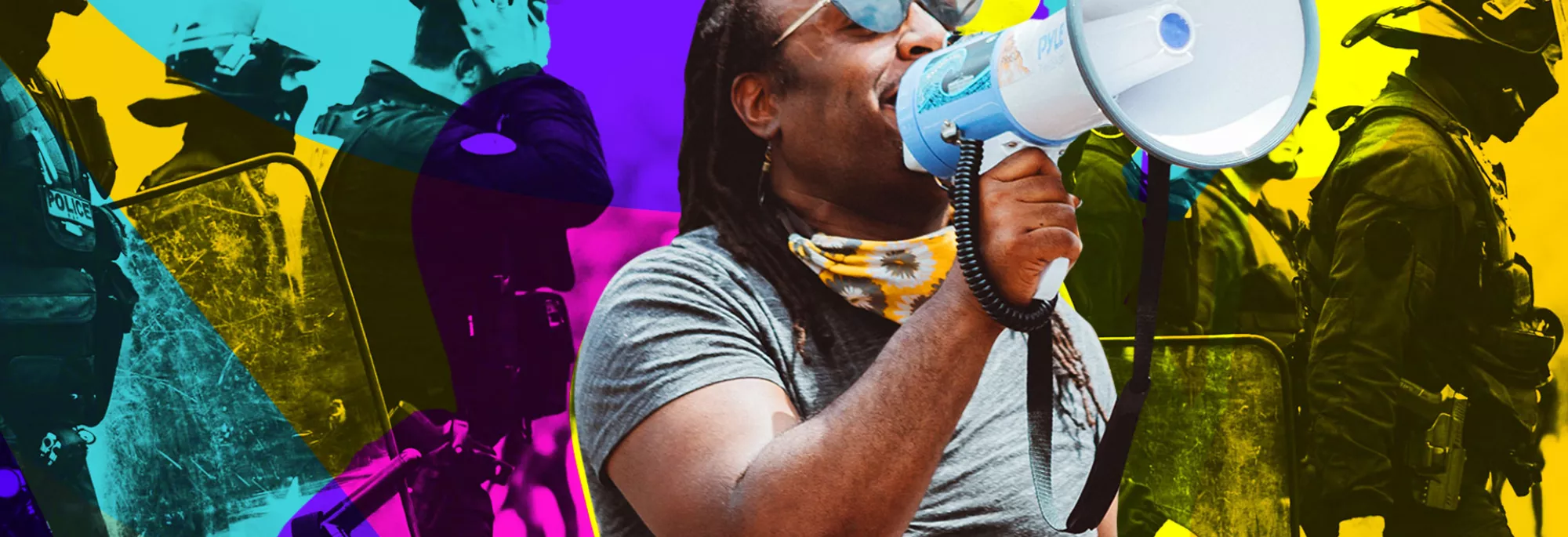
Meet other heroes who advanced racial justice
The voices of these visionaries shape our present and inform our future.
Join the fight
You are critical to the hard, complex work of ending racial inequality.

About Dr. Martin Luther King, Jr.
Dr. king jr..

Drawing inspiration from both his Christian faith and the peaceful teachings of Mahatma Gandhi, Dr. King led a nonviolent movement in the late 1950s and ‘ 60s to achieve legal equality for African-Americans in the United States. While others were advocating for freedom by “any means necessary,” including violence, Martin Luther King, Jr. used the power of words and acts of nonviolent resistance, such as protests, grassroots organizing, and civil disobedience to achieve seemingly-impossible goals. He went on to lead similar campaigns against poverty and international conflict, always maintaining fidelity to his principles that men and women everywhere, regardless of color or creed, are equal members of the human family.
Dr. King’s “I Have a Dream” speech, Nobel Peace Prize lecture and “Letter from a Birmingham Jail” are among the most revered orations and writings in the English language. His accomplishments are now taught to American children of all races, and his teachings are studied by scholars and students worldwide. He is the only non-president to have a national holiday dedicated in his honor and is the only non-president memorialized on the Great Mall in the nation’s capital. He is memorialized in hundreds of statues, parks, streets, squares, churches and other public facilities around the world as a leader whose teachings are increasingly-relevant to the progress of humankind.
Some of Dr. King’s Most Important Achievements

In 1957 , Dr. King was elected president of the Southern Christian Leadership Conference (SCLC), an organization designed to provide new leadership for the now burgeoning civil rights movement. He would serve as head of the SCLC until his assassination in 1968, a period during which he would emerge as the most important social leader of the modern American civil rights movement.
In 1963 , he led a coalition of numerous civil rights groups in a nonviolent campaign aimed at Birmingham, Alabama, which at the time was described as the “most segregated city in America.” The subsequent brutality of the city’s police, illustrated most vividly by television images of young blacks being assaulted by dogs and water hoses, led to a national outrage resulting in a push for unprecedented civil rights legislation. It was during this campaign that Dr. King drafted the “Letter from a Birmingham Jail,” the manifesto of Dr. King’s philosophy and tactics, which is today required-reading in universities worldwide.
Later in 1963 , Dr. King was one of the driving forces behind the March for Jobs and Freedom, more commonly known as the “March on Washington,” which drew over a quarter-million people to the national mall. It was at this march that Dr. King delivered his famous “I Have a Dream” speech, which cemented his status as a social change leader and helped inspire the nation to act on civil rights. Dr. King was later named Time magazine’s “Man of the Year.”

Also in 1964 , partly due to the March on Washington, Congress passed the landmark Civil Rights Act, essentially eliminating legalized racial segregation in the United States. The legislation made it illegal to discriminate against blacks or other minorities in hiring, public accommodations, education or transportation, areas which at the time were still very segregated in many places.
The next year, 1965 , Congress went on to pass the Voting Rights Act, which was an equally-important set of laws that eliminated the remaining barriers to voting for African-Americans, who in some locales had been almost completely disenfranchised. This legislation resulted directly from the Selma to Montgomery, AL March for Voting Rights lead by Dr. King.
Between 1965 and 1968, Dr. King shifted his focus toward economic justice – which he highlighted by leading several campaigns in Chicago, Illinois – and international peace – which he championed by speaking out strongly against the Vietnam War. His work in these years culminated in the “Poor Peoples Campaign,” which was a broad effort to assemble a multiracial coalition of impoverished Americans who would advocate for economic change.
Dr. Martin Luther King, Jr.’s less than thirteen years of nonviolent leadership ended abruptly and tragically on April 4th, 1968 , when he was assassinated at the Lorraine Motel in Memphis, Tennessee. Dr. King’s body was returned to his hometown of Atlanta, Georgia, where his funeral ceremony was attended by high-level leaders of all races and political stripes.
- For more information regarding the Transcription of the King Family Press Conference on the MLK Assassination Trial Verdict December 9, 1999, Atlanta, GA. Click Here
- For more information regarding the Civil Case: King family versus Jowers. Click here .
- Later in 1968, Dr. King’s wife, Mrs. Coretta Scott King, officially founded the Martin Luther King, Jr. Center for Nonviolent Social Change, which she dedicated to being a “living memorial” aimed at continuing Dr. King’s work on important social ills around the world.
We envision the Beloved Community where injustice ceases and love prevails.
Contact Info
449 Auburn Avenue, NE Atlanta, Georgia 30312
404.526.8900
Quick Links
- History Timeline
- King Holiday
- Privacy Policy
- Terms & Conditions
Latest News
- TKC Spotlight Series: The Federal Prison Oversight Act
- Our Words Matter
Stay Connected

Dr. King's Legacy
- Decent Housing
- Better Jobs & Higher Wages
- Quality Education
- 50 Voices for 50 Years
- 50 Weeks of Action Archive
The legacy of Dr. Martin Luther King Jr. encompasses influential decisions, monumental actions and steadfast progressions of humanitarian rights that reach far beyond the civil rights movement.
A leader of all people, Dr. King never chose fear, but always chose courage and determination when fighting for civil rights in the face of oppression, ignorance and violence. He refused to allow prison, violence or the threat of death sway his end mission. Instead, he stood beside his goal of achieving rights for all through nonviolent protests.
Dr. King maintained a vision for a more diverse America where all people enjoyed the benefits of equality. During a time when the opposition implemented legislation that withheld rights from people of color and expressed hatred through beatings and killings, Dr. King continued to take the high road.
He realized that violence would play into the scheme of the opposition. He knew that violent retaliation would fit exactly into the assumed mold that many had formed regarding civil rights activists. Because of that, he constantly preached that nonviolence will ultimately allow the opposition to prevail.
Dr. King also understood the impact of unifying the masses in the push for one common goal. Separately, attaining any significant progress would be a challenge. Collectively, he and other civil rights activists could affect policies and influence change nationwide. Dr. King’s leadership contributed to the overall success of the civil rights movement in the mid-1900s and continues to impact civil rights movements in the present.
While King and other leaders generated momentous strides for equality, the push for civil rights remains a preeminent challenge today. We continue to experience poverty in the inner cities. We continue to fight for equal pay regardless of gender or race. We continue to battle education inequality. We continue to call for justice for all.
Dr. King’s legacy provides a staple model for how we combat inequality today. We cannot get comfortable in our current state. Too many people are relying on us to recognize and fight the inequalities that exist today.
Dr. King’s generation did their part. Now, it’s time to do ours. The next generation needs us.
As you engage with Dr. King’s platforms and interact with the timeline of monumental civil rights accomplishments and events, reflect on how far we have come, and recall how far we have to go.
Dr. King's Legacy
Museum Hours for Today Today: 9:00 AM - 5:00 PM
- Skip to main content
- Keyboard shortcuts for audio player
Read Martin Luther King Jr.'s 'I Have a Dream' speech in its entirety

Civil rights leader Martin Luther King Jr. addresses the crowd at the Lincoln Memorial in Washington, D.C., where he gave his "I Have a Dream" speech on Aug. 28, 1963, as part of the March on Washington. AFP via Getty Images hide caption
Civil rights leader Martin Luther King Jr. addresses the crowd at the Lincoln Memorial in Washington, D.C., where he gave his "I Have a Dream" speech on Aug. 28, 1963, as part of the March on Washington.
Monday marks Martin Luther King, Jr. Day. Below is a transcript of his celebrated "I Have a Dream" speech, delivered on Aug. 28, 1963, on the steps of the Lincoln Memorial. NPR's Talk of the Nation aired the speech in 2010 — listen to that broadcast at the audio link above.

Martin Luther King Jr. and other civil rights leaders gather before a rally at the Lincoln Memorial on Aug. 28, 1963, in Washington. National Archives/Hulton Archive via Getty Images hide caption
Rev. Martin Luther King Jr.: Five score years ago, a great American, in whose symbolic shadow we stand today, signed the Emancipation Proclamation. This momentous decree came as a great beacon light of hope to millions of Negro slaves who had been seared in the flames of withering injustice. It came as a joyous daybreak to end the long night of their captivity.
But 100 years later, the Negro still is not free. One hundred years later, the life of the Negro is still sadly crippled by the manacles of segregation and the chains of discrimination. One hundred years later, the Negro lives on a lonely island of poverty in the midst of a vast ocean of material prosperity. One hundred years later the Negro is still languished in the corners of American society and finds himself in exile in his own land. And so we've come here today to dramatize a shameful condition. In a sense we've come to our nation's capital to cash a check.
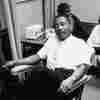
Code Switch
The power of martin luther king jr.'s anger.
When the architects of our republic wrote the magnificent words of the Constitution and the Declaration of Independence, they were signing a promissory note to which every American was to fall heir. This note was a promise that all men — yes, Black men as well as white men — would be guaranteed the unalienable rights of life, liberty and the pursuit of happiness.
It is obvious today that America has defaulted on this promissory note insofar as her citizens of color are concerned. Instead of honoring this sacred obligation, America has given the Negro people a bad check, a check which has come back marked insufficient funds.
But we refuse to believe that the bank of justice is bankrupt.
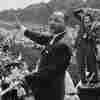
Martin Luther King is not your mascot
We refuse to believe that there are insufficient funds in the great vaults of opportunity of this nation. And so we've come to cash this check, a check that will give us upon demand the riches of freedom and the security of justice.
We have also come to this hallowed spot to remind America of the fierce urgency of now. This is no time to engage in the luxury of cooling off or to take the tranquilizing drug of gradualism.
Now is the time to make real the promises of democracy. Now is the time to rise from the dark and desolate valley of segregation to the sunlit path of racial justice. Now is the time to lift our nation from the quick sands of racial injustice to the solid rock of brotherhood. Now is the time to make justice a reality for all of God's children.

Civil rights protesters march from the Washington Monument to the Lincoln Memorial for the March on Washington on Aug. 28, 1963. Kurt Severin/Three Lions/Hulton Archive/Getty Images hide caption
It would be fatal for the nation to overlook the urgency of the moment. This sweltering summer of the Negro's legitimate discontent will not pass until there is an invigorating autumn of freedom and equality. 1963 is not an end, but a beginning. Those who hope that the Negro needed to blow off steam and will now be content will have a rude awakening if the nation returns to business as usual.
There will be neither rest nor tranquility in America until the Negro is granted his citizenship rights. The whirlwinds of revolt will continue to shake the foundations of our nation until the bright day of justice emerges.
But there is something that I must say to my people who stand on the warm threshold which leads into the palace of justice. In the process of gaining our rightful place, we must not be guilty of wrongful deeds. Let us not seek to satisfy our thirst for freedom by drinking from the cup of bitterness and hatred.
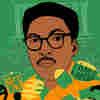
Throughline
Bayard rustin: the man behind the march on washington (2021).
We must forever conduct our struggle on the high plane of dignity and discipline. We must not allow our creative protest to degenerate into physical violence. Again and again, we must rise to the majestic heights of meeting physical force with soul force. The marvelous new militancy which has engulfed the Negro community must not lead us to a distrust of all white people, for many of our white brothers, as evidenced by their presence here today, have come to realize that their destiny is tied up with our destiny.
And they have come to realize that their freedom is inextricably bound to our freedom. We cannot walk alone. And as we walk, we must make the pledge that we shall always march ahead. We cannot turn back.
There are those who are asking the devotees of civil rights, when will you be satisfied? We can never be satisfied as long as the Negro is the victim of the unspeakable horrors of police brutality. We can never be satisfied as long as our bodies, heavy with the fatigue of travel, cannot gain lodging in the motels of the highways and the hotels of the cities.
We cannot be satisfied as long as the Negro's basic mobility is from a smaller ghetto to a larger one. We can never be satisfied as long as our children are stripped of their selfhood and robbed of their dignity by signs stating: for whites only.
We cannot be satisfied as long as a Negro in Mississippi cannot vote and a Negro in New York believes he has nothing for which to vote.
No, no, we are not satisfied, and we will not be satisfied until justice rolls down like waters, and righteousness like a mighty stream.
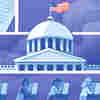
How The Voting Rights Act Came To Be And How It's Changed
I am not unmindful that some of you have come here out of great trials and tribulations. Some of you have come fresh from narrow jail cells. Some of you have come from areas where your quest for freedom left you battered by the storms of persecution and staggered by the winds of police brutality. You have been the veterans of creative suffering. Continue to work with the faith that unearned suffering is redemptive. Go back to Mississippi, go back to Alabama, go back to South Carolina, go back to Georgia, go back to Louisiana, go back to the slums and ghettos of our Northern cities, knowing that somehow this situation can and will be changed.
Let us not wallow in the valley of despair, I say to you today, my friends.
So even though we face the difficulties of today and tomorrow, I still have a dream. It is a dream deeply rooted in the American dream. I have a dream that one day this nation will rise up and live out the true meaning of its creed: We hold these truths to be self-evident, that all men are created equal.

People clap and sing along to a freedom song between speeches at the March on Washington for Jobs and Freedom in 1963. Express Newspapers via Getty Images hide caption
I have a dream that one day on the red hills of Georgia, the sons of former slaves and the sons of former slave owners will be able to sit down together at the table of brotherhood.
I have a dream that one day even the state of Mississippi, a state sweltering with the heat of injustice, sweltering with the heat of oppression will be transformed into an oasis of freedom and justice.
I have a dream that my four little children will one day live in a nation where they will not be judged by the color of their skin but by the content of their character. I have a dream today.
I have a dream that one day down in Alabama with its vicious racists, with its governor having his lips dripping with the words of interposition and nullification, one day right down in Alabama little Black boys and Black girls will be able to join hands with little white boys and white girls as sisters and brothers. I have a dream today.
I have a dream that one day every valley shall be exalted, every hill and mountain shall be made low, the rough places will be made plain, and the crooked places will be made straight, and the glory of the Lord shall be revealed, and all flesh shall see it together.
Nikole Hannah-Jones on the power of collective memory

- LISTEN & FOLLOW
- Apple Podcasts
- Amazon Music
Your support helps make our show possible and unlocks access to our sponsor-free feed.
This is our hope. This is the faith that I go back to the South with. With this faith, we will be able to hew out of the mountain of despair a stone of hope. With this faith we will be able to transform the jangling discords of our nation into a beautiful symphony of brotherhood. With this faith we will be able to work together, to pray together, to struggle together, to go to jail together, to stand up for freedom together, knowing that we will be free one day.
This will be the day when all of God's children will be able to sing with new meaning: My country, 'tis of thee, sweet land of liberty, of thee I sing. Land where my fathers died, land of the pilgrims' pride, from every mountainside, let freedom ring.
And if America is to be a great nation, this must become true. And so let freedom ring from the prodigious hilltops of New Hampshire. Let freedom ring from the mighty mountains of New York. Let freedom ring from the heightening Alleghenies of Pennsylvania. Let freedom ring from the snowcapped Rockies of Colorado. Let freedom ring from the curvaceous slopes of California. But not only that, let freedom ring from Stone Mountain of Georgia. Let freedom ring from Lookout Mountain of Tennessee. Let freedom ring from every hill and molehill of Mississippi. From every mountainside, let freedom ring.
And when this happens, and when we allow freedom ring, when we let it ring from every village and every hamlet, from every state and every city, we will be able to speed up that day when all of God's children, Black men and white men, Jews and Gentiles, Protestants and Catholics, will be able to join hands and sing in the words of the old Negro spiritual: Free at last. Free at last. Thank God almighty, we are free at last.
Correction Jan. 15, 2024
A previous version of this transcript included the line, "We have also come to his hallowed spot to remind America of the fierce urgency of now." The correct wording is "We have also come to this hallowed spot to remind America of the fierce urgency of now."
An Experiment in Love: Martin Luther King, Jr. on the Six Pillars of Nonviolent Resistance and the Ancient Greek Notion of ‘Agape’
By maria popova.

Nowhere does he transmute spiritual ideas from various traditions into secular principles more masterfully than in his extraordinary 1958 essay “An Experiment in Love,” in which he examines the six essential principles of his philosophy of nonviolence, debunks popular misconceptions about it, and considers how these basic tenets can be used in guiding any successful movement of nonviolent resistance. Penned five years before his famous Letter from Birmingham City Jail and exactly a decade before his assassination, the essay was eventually included in the indispensable A Testament of Hope: The Essential Writings and Speeches of Martin Luther King, Jr. ( public library ) — required reading for every human being with a clicking mind and a ticking heart.

In the first of the six basic philosophies, Dr. King addresses the tendency to mistake nonviolence for passivity, pointing out that it is a form not of cowardice but of courage:
It must be emphasized that nonviolent resistance is not a method for cowards; it does resist. If one uses this method because he is afraid or merely because he lacks the instruments of violence, he is not truly nonviolent. This is why Gandhi often said that if cowardice is the only alternative to violence, it is better to fight… The way of nonviolent resistance … is ultimately the way of the strong man. It is not a method of stagnant passivity… For while the nonviolent resister is passive in the sense that he is not physically aggressive toward his opponent, his mind and his emotions are always active, constantly seeking to persuade his opponent that he is wrong. The method is passive physically but strongly active spiritually. It is not passive non-resistance to evil, it is active nonviolent resistance to evil.
He turns to the second tenet of nonviolence:
Nonviolence … does not seek to defeat or humiliate the opponent, but to win his friendship and understanding. The nonviolent resister must often express his protest through noncooperation or boycotts, but he realizes that these are not ends themselves; they are merely means to awaken a sense of moral shame in the opponent. The end is redemption and reconciliation. The aftermath of nonviolence is the creation of the beloved community, while the aftermath of violence is tragic bitterness.

In considering the third characteristic of nonviolence, Dr. King appeals to the conscientious recognition that those who perpetrate violence are often victims themselves:
The attack is directed against forces of evil rather than against persons who happen to be doing the evil. It is the evil that the nonviolent resister seeks to defeat, not the persons victimized by the evil. If he is opposing racial injustice, the nonviolent resister has the vision to see that the basic tension is not between the races… The tension is, at bottom, between justice and injustice, between the forces of light and the forces of darkness…. We are out to defeat injustice and not white persons who may be unjust.
Out of this recognition flows the fourth tenet:
Nonviolent resistance [requires] a willingness to accept suffering without retaliation, to accept blows from the opponent without striking back… The nonviolent resister is willing to accept violence if necessary, but never to inflict it. He does not seek to dodge jail. If going to jail is necessary, he enters it “as a bridegroom enters the bride’s chamber.”
That, in fact, is precisely how Dr. King himself entered jail five years later . To those skeptical of the value of turning the other cheek, he offers:
Unearned suffering is redemptive. Suffering, the nonviolent resister realizes, has tremendous educational and transforming possibilities.
The fifth basic philosophy turns the fourth inward and arrives at the most central point of the essay — the noblest use of what we call “love”:
Nonviolent resistance … avoids not only external physical violence but also internal violence of spirit. The nonviolent resister not only refuses to shoot his opponent but he also refuses to hate him. At the center of nonviolence stands the principle of love. The nonviolent resister would contend that in the struggle for human dignity, the oppressed people of the world must not succumb to the temptation of becoming bitter or indulging in hate campaigns. To retaliate in kind would do nothing but intensify the existence of hate in the universe. Along the way of life, someone must have sense enough and morality enough to cut off the chain of hate. This can only be done by projecting the ethic of love to the center of our lives.

Here, Dr. King turns to Ancient Greek philosophy, pointing out that the love he speaks of is not the sentimental or affectionate kind — “it would be nonsense to urge men to love their oppressors in an affectionate sense,” he readily acknowledges — but love in the sense of understanding and redemptive goodwill. The Greeks called this agape — a love distinctly different from the eros , reserved for our lovers, or philia , with which we love our friends and family. Dr. King explains:
Agape means understanding, redeeming good will for all men. It is an overflowing love which is purely spontaneous, unmotivated, groundless, and creative. It is not set in motion by any quality or function of its object… Agape is disinterested love. It is a love in which the individual seeks not his own good, but the good of his neighbor. Agape does not begin by discriminating between worthy and unworthy people, or any qualities people possess. It begins by loving others for their sakes . It is an entirely “neighbor-regarding concern for others,” which discovers the neighbor in every man it meets. Therefore, agape makes no distinction between friends and enemy; it is directed toward both. If one loves an individual merely on account of his friendliness, he loves him for the sake of the benefits to be gained from the friendship, rather than for the friend’s own sake. Consequently, the best way to assure oneself that love is disinterested is to have love for the enemy-neighbor from whom you can expect no good in return, but only hostility and persecution.
This notion is nearly identical to one of Buddhism’s four brahmaviharas , or divine attitudes — the concept of Metta , often translated as lovingkindness or benevolence. The parallel speaks not only to Dr. King’s extraordinarily diverse intellectual toolkit of influences and inspirations — a high form of combinatorial creativity necessary for any meaningful contribution to humanity’s common record — but also to the core commonalities between the world’s major spiritual and philosophical traditions.
In a sentiment that Margaret Mead and James Baldwin would echo twelve years later in their spectacular conversation on race — “In any oppressive situation both groups suffer, the oppressors and the oppressed,” Mead observed, asserting that the oppressors suffer morally with the recognition of what they’re committing, which Baldwin noted is “a worse kind of suffering” — Dr. King adds:
Another basic point about agape is that it springs from the need of the other person — his need for belonging to the best in the human family… Since the white man’s personality is greatly distorted by segregation, and his soul is greatly scarred, he needs the love of the Negro. The Negro must love the white man, because the white man needs his love to remove his tensions, insecurities, and fears.

At the heart of agape , he argues, is the notion of forgiveness — something Mead and Baldwin also explored with great intellectual elegance . Dr. King writes:
Agape is not a weak, passive love. It is love in action… Agape is a willingness to go to any length to restore community… It is a willingness to forgive, not seven times, but seventy times seven to restore community…. If I respond to hate with a reciprocal hate I do nothing but intensify the cleavage in broken community. I can only close the gap in broken community by meeting hate with love.
With this, he turns to the sixth and final principle of nonviolence as a force of justice, undergirded by the nonreligious form of spirituality that Dani Shapiro elegantly termed “an animating presence” and Alan Lightman described as the transcendence of “this strange and shimmering world.” Dr. King writes:
Nonviolent resistance … is based on the conviction that the universe is on the side of justice. Consequently, the believer in nonviolence has deep faith in the future. This faith is another reason why the nonviolent resister can accept suffering without retaliation. For he knows that in his struggle for justice he has cosmic companionship. It is true that there are devout believers in nonviolence who find it difficult to believe in a personal God. But even these persons believe in the existence of some creative force that works for universal wholeness. Whether we call it an unconscious process, an impersonal Brahman, or a Personal Being of matchless power of infinite love, there is a creative force in this universe that works to bring the disconnected aspects of reality into a harmonious whole.
A Testament of Hope is an absolutely essential read in its totality. Complement it with Dr. King on the two types of law , Albert Einstein’s little-known correspondence with W.E.B. Du Bois on racial justice , and Tolstoy and Gandhi’s equally forgotten but immensely timely correspondence on why we hurt each other .
— Published July 1, 2015 — https://www.themarginalian.org/2015/07/01/martin-luther-king-jr-an-experiment-in-love/ —

www.themarginalian.org

PRINT ARTICLE
Email article, filed under, activism culture history love martin luther king philosophy politics psychology, view full site.
The Marginalian participates in the Bookshop.org and Amazon.com affiliate programs, designed to provide a means for sites to earn commissions by linking to books. In more human terms, this means that whenever you buy a book from a link here, I receive a small percentage of its price, which goes straight back into my own colossal biblioexpenses. Privacy policy . (TLDR: You're safe — there are no nefarious "third parties" lurking on my watch or shedding crumbs of the "cookies" the rest of the internet uses.)
Home — Essay Samples — Social Issues — Martin Luther King — Martin Luther King Jr.: Life and Legacy of a Civil Rights Icon
Martin Luther King Jr.: Life and Legacy of a Civil Rights Icon
- Categories: Civil Rights Martin Luther King Racial Discrimination
About this sample

Words: 854 |
Published: Feb 9, 2022
Words: 854 | Pages: 2 | 5 min read
Table of contents
Martin luther king jr essay outline, martin luther king jr essay example, introduction.
- Introduction to Martin Luther King Jr.'s life, significance, and the enduring relevance of racial equality
Early Life and Childhood
- Background information on Martin Luther King Jr.'s family and upbringing
- Early experiences with racism and segregation
Struggles and Influences
- King's personal battles with depression and encounters with racism
- Impactful events in King's youth, including a traumatic incident on a bus
Involvement in the Civil Rights Movement
- Martin Luther King Jr.'s role in the Montgomery Bus Boycott
- Leadership in the Southern Christian Leadership Conference (SCLC)
The "I Have a Dream" Speech
- Overview of the March on Washington for Jobs and Freedom
- Martin Luther King Jr.'s iconic "I Have a Dream" speech
Assassination and Legacy
- Details of Martin Luther King Jr.'s assassination in Memphis
- International and national recognition of King's legacy
- Observance of Martin Luther King Jr. Day
Works Cited:
- Chick, N. L. (2018). The power of literacy narratives: Using stories to guide teachers' professional growth. In D. K. Dickinson, S. B. Neuman, & D. K. Parker (Eds.), Handbook of early literacy research (Vol. 3, pp. 309-327). Guilford Press.
- De Ford, D. A. (2015). Literacy narratives: Stories of literacy and language learning. In G. Poole & L. May (Eds.), Language and literacy learning in schools (pp. 47-62). Routledge.
- Flower, L. (2008). The construction of personal narratives in reading and writing. In S. Ransdell & M. L. Barbier (Eds.), Reading and writing connections: Connections to the classroom (pp. 77-94). Springer.
- Gee, J. P. (2015). Social linguistics and literacies: Ideology in discourses (5th ed.). Routledge.
- Heath, S. B. (1983). Ways with words: Language, life, and work in communities and classrooms. Cambridge University Press.
- Nussbaum, M. (2012). Not for profit: Why democracy needs the humanities. Princeton University Press.
- Perry, T. (2014). Literacy narratives and the struggle to define literacy. College Composition and Communication, 66(1), 21-43.
- Rose, M. (2012). Why school?: Reclaiming education for all of us. New Press.
- Soliday, M. (2013). Everyday genres: Writing assignments across the disciplines. University Press of Colorado.
- Street, B. (2014). Literacy in theory and practice (Vol. 11). Cambridge University Press.

Cite this Essay
To export a reference to this article please select a referencing style below:
Let us write you an essay from scratch
- 450+ experts on 30 subjects ready to help
- Custom essay delivered in as few as 3 hours
Get high-quality help

Prof. Kifaru
Verified writer
- Expert in: Social Issues

+ 120 experts online
By clicking “Check Writers’ Offers”, you agree to our terms of service and privacy policy . We’ll occasionally send you promo and account related email
No need to pay just yet!
Related Essays
1 pages / 635 words
3 pages / 1394 words
2 pages / 711 words
2 pages / 1110 words
Remember! This is just a sample.
You can get your custom paper by one of our expert writers.
121 writers online
Still can’t find what you need?
Browse our vast selection of original essay samples, each expertly formatted and styled
Related Essays on Martin Luther King
Throughout history, there have been many influential figures who have advocated for the rights and equality of African Americans. Two prominent leaders in the fight against racial discrimination were Booker T. Washington and [...]
In Martin Luther King Jr.'s famous "Letter from Birmingham Jail," he employs the rhetorical device of juxtaposition to highlight the stark contrast between the realities faced by African Americans and the hypocritical attitudes [...]
Throughout history, there have been many influential leaders who have fought for justice and equality. Cesar Chavez, a prominent civil rights activist, delivered a powerful speech in which he compared his followers to those of [...]
On April 12, 1963, Dr. Martin Luther King Jr. penned a letter from his solitary confinement in Birmingham Jail, addressing his critics and defending the nonviolent civil rights movement. In his eloquent and thought-provoking [...]
On August 28, 1963 Reverend Martin Luther King Jr. gave the monumental I Have a Dream speech. One hundred years earlier, the Emancipation Proclamation had been issued in 1863 freeing all the slaves. Two years later the Civil War [...]
Martin Luther’s To the Christian Nobility Of the German Nation effectively questions why religious clergy are superior to the common man. In this Luther is effectively inciting the Protestant Reformation. Not only does this [...]
Related Topics
By clicking “Send”, you agree to our Terms of service and Privacy statement . We will occasionally send you account related emails.
Where do you want us to send this sample?
By clicking “Continue”, you agree to our terms of service and privacy policy.
Be careful. This essay is not unique
This essay was donated by a student and is likely to have been used and submitted before
Download this Sample
Free samples may contain mistakes and not unique parts
Sorry, we could not paraphrase this essay. Our professional writers can rewrite it and get you a unique paper.
Please check your inbox.
We can write you a custom essay that will follow your exact instructions and meet the deadlines. Let's fix your grades together!
Get Your Personalized Essay in 3 Hours or Less!
We use cookies to personalyze your web-site experience. By continuing we’ll assume you board with our cookie policy .
- Instructions Followed To The Letter
- Deadlines Met At Every Stage
- Unique And Plagiarism Free

- History & Society
- Science & Tech
- Biographies
- Animals & Nature
- Geography & Travel
- Arts & Culture
- Games & Quizzes
- On This Day
- One Good Fact
- New Articles
- Lifestyles & Social Issues
- Philosophy & Religion
- Politics, Law & Government
- World History
- Health & Medicine
- Browse Biographies
- Birds, Reptiles & Other Vertebrates
- Bugs, Mollusks & Other Invertebrates
- Environment
- Fossils & Geologic Time
- Entertainment & Pop Culture
- Sports & Recreation
- Visual Arts
- Demystified
- Image Galleries
- Infographics
- Top Questions
- Britannica Kids
- Saving Earth
- Space Next 50
- Student Center

- What is racism?
- What are some of the societal aspects of racism?
- What are some of the measures taken to combat racism?
- What are civil rights?
- Where do civil rights come from?

I Have a Dream
Our editors will review what you’ve submitted and determine whether to revise the article.
- Yale Law School - Lillian Goldman Law Library - The Avalon Project - I have a Dream by Martin Luther King, Jr; August 28, 1963
- Stanford University - The Martin Luther King, Jr., Research and Education Institute - "I Have a Dream"
- NPR - Read Martin Luther King Jr.'s 'I Have a Dream' speech in its entirety
- Marshall University - OneMarshallU - "I Have A Dream"
- Teach Tennessee History - "I Have a Dream..."
- Library of Congress - “I Have a Dream” Speech by Dr. Martin Luther King, Jr. (August 28, 1963)
- The Gilder Lehrman Institute of American History - “I Hav e a Dream ” Speech by the Rev. Martin Luther King Jr. at the “March on Washington,” 1963
- U.S. Embassy & Consulate in the Republic of Korea - Martin Luther King, Jr. : I Have a Dream Speech (1963)
I Have a Dream , speech by Martin Luther King, Jr. , that was delivered on August 28, 1963, during the March on Washington . A call for equality and freedom , it became one of the defining moments of the civil rights movement and one of the most iconic speeches in American history.

Some 250,000 people gathered at the Lincoln Memorial in Washington, D.C. , for the March on Washington. The one-day event both protested racial discrimination and encouraged the passage of civil rights legislation; at the time, the Civil Rights Act was being discussed in Congress. The march featured various speeches as well as musical performances before King, a celebrated orator, appeared as the final official speaker; A. Philip Randolph and Benjamin Mays ended the proceedings with a pledge and a benediction , respectively.

Early in his prepared speech, King referenced Abraham Lincoln ’s Gettysburg Address with “Five score years ago….” He then spoke about the Emancipation Proclamation , which “end[ed] the long night of their [slaves’] captivity.” However, he continued by noting that African Americans were still “not free” and that they were “crippled by the manacles of segregation and the chains of discrimination.”

According to various observers, however, as King neared the end, the address was failing to achieve the resonance of his more noteworthy speeches. As activist John Lewis noted, King himself could “sense that he was falling short.” Perhaps that compelled singer Mahalia Jackson to call out, imploring him to tell the crowd about “the dream.” It was a theme he had used at earlier events but had been advised not to use in Washington, with one aide calling it “trite.” At Jackson’s urging, however, King abandoned his prepared text and launched into a discussion of his dreams, adopting “the stance of a Baptist preacher.”
I say to you today, my friends, so even though we face the difficulties of today and tomorrow, I still have a dream. It is a dream deeply rooted in the American dream.…I have a dream that my four little children will one day live in a nation where they will not be judged by the color of their skin but by the content of their character. I have a dream that…one day right there in Alabama, little Black boys and Black girls will be able to join hands with little white boys and white girls as sisters and brothers.
King’s improvisations seemed to strike a chord with the crowd, many of whom called out words of encouragement. The speech built to its emotional conclusion , which was borrowed from a Black spiritual : “Free at last. Free at last. Thank God Almighty, we are free at last.” Largely based on King’s extemporizations, the speech was widely considered the greatest of the 20th century, noted for its power and resonance. With its universal appeal, “I have a dream” became an enduring phrase both in the United States and elsewhere. In addition, many believed the speech helped secure passage of the Civil Rights Act in 1964.
Martin L. King Jr
Martin Luther King Jr's Quotes for UPSC Essay Paper - Meaning with Usage
Martin luther king jr’s quotes for upsc essay paper – meaning with usage.
Discover Martin Luther King Jr’s inspiring quotes for UPSC Essay Paper excellence. Explore the powerful messages behind his words on civil rights, equality, and social justice. Learn to effectively incorporate these impactful statements into your essays, enriching your writing with King’s vision of hope and change.
Martin Luther King Jr.
Click on Quote to See Meaning & Usage in Essay
“Faith is taking the first step even when you can’t see the whole staircase” – Martin Luther King Jr.
“The ultimate measure of a man is not where he stands in moments of comfort and convenience, but where he stands at times of challenge and controversy” – Martin Luther King Jr.
“Never forget that everything Hitler did in Germany was legal” – Martin Luther King Jr.
“Our scientific power has outrun our spiritual power. We have guided missiles and misguided men” – Martin Luther King Jr.
“If you can’t fly then run, if you can’t run then walk, if you can’t walk then crawl, but whatever may do you have to keep moving forward” – Martin Luther King Jr.
“Life’s most persistent and urgent question is : What are you doing for others?”” – Martin Luther King Jr.
“One has a moral responsibility to disobey unjust laws” – Martin Luther King Jr.
“It has always been a mystery to me how men can feel themselves honoured by the humiliation of their fellow beings” – Martin Luther King Jr.
“Injustice anywhere is a threat to justice everywhere” – Martin Luther King Jr.
“In matter of conscience, the law of majority has no place” – Martin Luther King Jr.
“A right delayed is a right denied” – Martin Luther King Jr.
“Lightning makes no sound until it strikes” – Martin Luther King Jr.
“If I cannot do great things, I can do small things in a great way” – Martin Luther King Jr.
“Non-cooperation with evil is as much a duty as is cooperation with good” – Martin Luther King Jr.
“Our lives begin to end the day we become silent about things that matter” – Martin Luther King Jr.
“Victory attained by violence is tantamount to defeat, for it is temporary” – Martin Luther King Jr.
“The time is always right to do the right thing” – Martin Luther King Jr.
“There comes a time when silence is betrayal” – Martin Luther King Jr.
“Never, never be afraid to do what’s right, especially if the well-being of a person or animal is at stake. Society’s punishments are small compared to the wounds we inflict on our soul when we look the other way” – Martin Luther King Jr.
“Love is the only force capable of transforming an enemy to a friend” – Martin Luther King Jr.
“Darkness can’t drive out darkness, only light can do that. Hate cannot drive out hate, only love can do that” – Martin Luther King Jr.
“It’s the action and not the fruit of the action which is important” – Martin Luther King Jr.
“Public opinion alone can keep a society pure and healthy” – Martin Luther King Jr.
“Not everybody can be famous but everybody can be great, because greatness is determined by service” – Martin Luther King Jr.
“A man who won’t die for something is not fit to live” – Martin Luther King Jr.
“We must accept finite disappointment, but never lose infinite hope” – Martin Luther King Jr.
“There comes a time when one must take a position that is neither safe,nor politic, nor popular, but he must take it because conscience tells him it is right” – Martin Luther King Jr.
“Wars are poor chisels for carving out peaceful tomorrows” – Martin Luther King Jr.
Three Essays on Religion
Author: King, Martin Luther, Jr.
Date: September 1, 1948 to May 31, 1951 ?
Location: Chester, Pa. ?
Genre: Essay
Topic: Martin Luther King, Jr. - Education
In the following three essays, King wrestles with the role of religion in modern society. In the first assignment, he calls science and religion “different though converging truths” that both “spring from the same seeds of vital human needs.” King emphasizes an awareness of God’s presence in the second document, noting that religion’s purpose “is not to perpetuate a dogma or a theology; but to produce living witnesses and testimonies to the power of God in human experience.” In the final handwritten essay King acknowledges the life-affirming nature of Christianity, observing that its adherents have consistently “looked forward for a time to come when the law of love becomes the law of life.”
"Science and Religion"
There is widespread belief in the minds of many that there is a conflict between science and religion. But there is no fundamental issue between the two. While the conflict has been waged long and furiously, it has been on issues utterly unrelated either to religion or to science. The conflict has been largely one of trespassing, and as soon as religion and science discover their legitimate spheres the conflict ceases.
Religion, of course, has been very slow and loath to surrender its claim to sovereignty in all departments of human life; and science overjoyed with recent victories, has been quick to lay claim to a similar sovereignty. Hence the conflict.
But there was never a conflict between religion and science as such. There cannot be. Their respective worlds are different. Their methods are dissimilar and their immediate objectives are not the same. The method of science is observation, that of religion contemplation. Science investigates. Religion interprets. One seeks causes, the other ends. Science thinks in terms of history, religion in terms of teleology. One is a survey, the other an outlook.
The conflict was always between superstition disguised as religion and materialism disguised as science, between pseudo-science and pseudo-religion.
Religion and science are two hemispheres of human thought. They are different though converging truths. Both science and religion spring from the same seeds of vital human needs.
Science is the response to the human need of knowledge and power. Religion is the response to the human need for hope and certitude. One is an outreaching for mastery, the other for perfection. Both are man-made, and like man himself, are hedged about with limitations. Neither science nor religion, by itself, is sufficient for man. Science is not civilization. Science is organized knowledge; but civilization which is the art of noble and progressive communal living requires much more than knowledge. It needs beauty which is art, and faith and moral aspiration which are religion. It needs artistic and spiritual values along with the intellectual.
Man cannot live by facts alone. What we know is little enough. What we are likely to know will always be little in comparison with what there is to know. But man has a wish-life which must build inverted pyramids upon the apexes of known facts. This is not logical. It is, however, psychological.
Science and religion are not rivals. It is only when one attempts to be the oracle at the others shrine that confusion arises. Whan the scientist from his laboratory, on the basis of alleged scientific knowledge presumes to issue pronouncements on God, on the origin and destiny of life, and on man’s place in the scheme of things he is [ passing? ] out worthless checks. When the religionist delivers ultimatums to the scientist on the basis of certain cosomologies embedded in the sacred text then he is a sorry spectacle indeed.
When religion, however, on the strength of its own postulates, speaks to men of God and the moral order of the universe, when it utters its prophetic burden of justice and love and holiness and peace, then its voice is the voice of the eternal spiritual truth, irrefutable and invincible.,
"The Purpose of Religion"
What is the purpose of religion? 1 Is it to perpetuate an idea about God? Is it totally dependent upon revelation? What part does psychological experience play? Is religion synonymous with theology?
Harry Emerson Fosdick says that the most hopeful thing about any system of theology is that it will not last. 2 This statement will shock some. But is the purpose of religion the perpetuation of theological ideas? Religion is not validated by ideas, but by experience.
This automatically raises the question of salvation. Is the basis for salvation in creeds and dogmas or in experience. Catholics would have us believe the former. For them, the church, its creeds, its popes and bishops have recited the essence of religion and that is all there is to it. On the other hand we say that each soul must make its own reconciliation to God; that no creed can take the place of that personal experience. This was expressed by Paul Tillich when he said, “There is natural religion which belongs to man by nature. But there is also a revealed religion which man receives from a supernatural reality.” 3 Relevant religion therefore, comes through revelation from God, on the one hand; and through repentance and acceptance of salvation on the other hand. 4 Dogma as an agent in salvation has no essential place.
This is the secret of our religion. This is what makes the saints move on in spite of problems and perplexities of life that they must face. This religion of experience by which man is aware of God seeking him and saving him helps him to see the hands of God moving through history.
Religion has to be interpreted for each age; stated in terms that that age can understand. But the essential purpose of religion remains the same. It is not to perpetuate a dogma or theology; but to produce living witnesses and testimonies to the power of God in human experience.
[ signed ] M. L. King Jr. 5
"The Philosophy of Life Undergirding Christianity and the Christian Ministry"
Basically Christianity is a value philosophy. It insists that there are eternal values of intrinsic, self-evidencing validity and worth, embracing the true and the beautiful and consummated in the Good. This value content is embodied in the life of Christ. So that Christian philosophy is first and foremost Christocentric. It begins and ends with the assumption that Christ is the revelation of God. 6
We might ask what are some of the specific values that Christianity seeks to conserve? First Christianity speaks of the value of the world. In its conception of the world, it is not negative; it stands over against the asceticisms, world denials, and world flights, for example, of the religions of India, and is world-affirming, life affirming, life creating. Gautama bids us flee from the world, but Jesus would have us use it, because God has made it for our sustenance, our discipline, and our happiness. 7 So that the Christian view of the world can be summed up by saying that it is a place in which God is fitting men and women for the Kingdom of God.
Christianity also insists on the value of persons. All human personality is supremely worthful. This is something of what Schweitzer has called “reverence for life.” 8 Hunan being must always be used as ends; never as means. I realize that there have been times that Christianity has short at this point. There have been periods in Christians history that persons have been dealt with as if they were means rather than ends. But Christianity at its highest and best has always insisted that persons are intrinsically valuable. And so it is the job of the Christian to love every man because God love love. We must not love men merely because of their social or economic position or because of their cultural contribution, but we are to love them because God they are of value to God.
Christianity is also concerned about the value of life itself. Christianity is concerned about the good life for every child, man, and woman and child. This concern for the good life and the value of life is no where better expressed than in the words of Jesus in the gospel of John: “I came that you might have life and that you might have it more abundantly.” 9 This emphasis has run throughout the Christian tradition. Christianity has always had a concern for the elimination of disease and pestilence. This is seen in the great interest that it has taken in the hospital movement.
Christianity is concerned about increasing value. The whole concept of the kingdom of God on earth expressing a concern for increasing value. We need not go into a dicussion of the nature and meaning of the Kingdom of God, only to say that Christians throughout the ages have held tenaciouly to this concept. They have looked forward for a time to come when the law of love becomes the law of life.
In the light of all that we have said about Christianity as a value philosophy, where does the ministry come into the picture? 10
1. King may have also considered the purpose of religion in a Morehouse paper that is no longer extant, as he began a third Morehouse paper, “Last week we attempted to discuss the purpose of religion” (King, “The Purpose of Education,” September 1946–February 1947, in Papers 1:122).
2. “Harry Emerson Fosdick” in American Spiritual Autobiographies: Fifteen Self-Portraits, ed. Louis Finkelstein (New York: Harper & Brothers, 1948), p. 114: “The theology of any generation cannot be understood, apart from the conditioning social matrix in which it is formulated. All systems of theology are as transient as the cultures they are patterned from.”
3. King further developed this theme in his dissertation: “[Tillich] finds a basis for God’s transcendence in the conception of God as abyss. There is a basic inconsistency in Tillich’s thought at this point. On the one hand he speaks as a religious naturalist making God wholly immanent in nature. On the other hand he speaks as an extreme supernaturalist making God almost comparable to the Barthian ‘wholly other’” (King, “A Comparison of the Conceptions of God in the Thinking of Paul Tillich and Henry Nelson Wieman,” 15 April 1955, in Papers 2:535).
4. Commas were added after the words “religion” and “salvation.”
5. King folded this assignment lengthwise and signed his name on the verso of the last page.
6. King also penned a brief outline with this title (King, “The Philosophy of Life Undergirding Christianity and the Christian Ministry,” Outline, September 1948–May 1951). In the outline, King included the reference “see Enc. Of Religion p. 162.” This entry in An Encyclopedia of Religion , ed. Vergilius Ferm (New York: Philosophical Library, 1946) contains a definition of Christianity as “Christo-centric” and as consisting “of eternal values of intrinsic, self-evidencing validity and worth, embracing the true and the beautiful and consummated in the Good.” King kept this book in his personal library.
7. Siddhartha Gautama (ca. 563–ca. 483 BCE) was the historical Buddha.
8. For an example of Schweitzer’s use of the phrase “reverence for life,” see Albert Schweitzer, “The Ethics of Reverence for Life,” Christendom 1 (1936): 225–239.
9. John 10:10.
10. In his outline for this paper, King elaborated: “The Ministry provides leadership in helping men to recognize and accept the eternal values in the Xty religion. a. The necessity of a call b. The necessity for disinterested love c. The [ necessity ] for moral uprightness” (King, “Philosophy of Life,” Outline, September 1948–May 1951).
Source: CSKC-INP, Coretta Scott King Collection, In Private Hands, Sermon file.
© Copyright Information

IMAGES
VIDEO
COMMENTS
Martin Luther King, Jr. - Civil Rights, Nonviolence, Equality: In the years after his death, King remained the most widely known African American leader of his era. His stature as a major historical figure was confirmed by the successful campaign to establish a national holiday in his honor in the United States and by the building of a King memorial on the Mall in Washington, D.C., near the ...
Stephen F. Somerstein/Getty Images. Martin Luther King Jr. was a social activist and Baptist minister who played a key role in the American civil rights movement from the mid-1950s until his ...
Martin Luther King, Jr. (born January 15, 1929, Atlanta, Georgia, U.S.—died April 4, 1968, Memphis, Tennessee) was a Baptist minister and social activist who led the civil rights movement in the United States from the mid-1950s until his death by assassination in 1968.
By Dr Oliver Tearle (Loughborough University) 'I Have a Dream' is one of the greatest speeches in American history. Delivered by Martin Luther King, Jr. (1929-68) in Washington D.C. in 1963, the speech is a powerful rallying cry for racial equality and for a fairer and equal world in which African Americans will be as free as white Americans.
Martin Luther King Jr. was a social activist and Baptist minister who played a key role in the American civil rights movement from the mid-1950s until his assassination in 1968. Explore his life ...
Martin Luther King Jr. (born Michael King Jr.; January 15, 1929 - April 4, 1968) was an American Baptist minister, activist, and political philosopher who was one of the most prominent leaders in the civil rights movement from 1955 until his assassination in 1968. King advanced civil rights for people of color in the United States through the use of nonviolent resistance and nonviolent civil ...
This year's Martin Luther King Jr. Day, on January 15, coincides with the late civil rights leader 's birthday. Had he lived, King would be turning 95 years old. Days after his 1968 ...
A Quarter Million People and a Dream. On August 28, 1963, more than a quarter million people participated in the historic March on Washington for Jobs and Freedom, gathering near the Lincoln Memorial. More than 3,000 members of the press covered this historic march, where Rev. Dr. Martin Luther King, Jr. delivered the exalted "I Have a Dream ...
During the less than 13 years of Dr. Martin Luther King, Jr.'s leadership of the modern American Civil Rights Movement, from December 1955 until April 4, 1968, African Americans achieved more genuine progress toward racial equality in America than the previous 350 years had produced. Dr. King is widely regarded as America's pre-eminent advocate of nonviolence and one of the greatest ...
The legacy of Dr. Martin Luther King Jr. encompasses influential decisions, monumental actions and steadfast progressions of humanitarian rights that reach far beyond the civil rights movement. A leader of all people, Dr. King never chose fear, but always chose courage and determination when fighting for civil rights in the face of oppression ...
During this event, Martin Luther King delivered his memorable ... 25 October 1958, in Papers 4:514-515. King, "Give Us the Ballot," Address Delivered at the Prayer Pilgrimage for Freedom, 17 May 1957, in Papers 4:208-215. King, "I Have a Dream," Address Delivered at the March on Washington for Jobs and Freedom, ...
August 28, 1963. Martin Luther King's famous "I Have a Dream" speech, delivered at the 28 August 1963 March on Washington for Jobs and Freedom, synthesized portions of his previous sermons and speeches, with selected statements by other prominent public figures.. King had been drawing on material he used in the "I Have a Dream" speech in his other speeches and sermons for many years.
AFP via Getty Images. Monday marks Martin Luther King, Jr. Day. Below is a transcript of his celebrated "I Have a Dream" speech, delivered on Aug. 28, 1963, on the steps of the Lincoln Memorial ...
Introduction. Martin Luther King, Jr., made history, but he was also transformed by his deep family roots in the African-American Baptist church, his formative experiences in his hometown of Atlanta, his theological studies, his varied models of religious and political leadership, and his extensive network of contacts in the peace and social ...
Although Dr. Martin Luther King, Jr. (January 15, 1929-April 4, 1968) used Christian social ethics and the New Testament concept of "love" heavily in his writings and speeches, he was as influenced by Eastern spiritual traditions, Gandhi's political writings, Buddhism's notion of the interconnectedness of all beings, and Ancient Greek philosophy.
Martin Luther King Jr Essay Outline Introduction. Introduction to Martin Luther King Jr.'s life, significance, and the enduring relevance of racial equality; Early Life and Childhood. Background information on Martin Luther King Jr.'s family and upbringing; Early experiences with racism and segregation; Struggles and Influences
Amy Tikkanen. I Have a Dream, the speech by civil rights leader Martin Luther King, Jr., that was delivered on August 28, 1963, during the March on Washington. A call for equality and freedom, it became one of the defining moments of the civil rights movement and one of the most iconic speeches in American history.
Author: King, Martin Luther, Jr. (Morehouse College) Date: January 1, 1947 to February 28, 1947 Location: Atlanta, Ga. Genre: Published Article Topic: Martin Luther King, Jr. - Political and Social Views Details. Writing in the campus newspaper, the Maroon Tiger, King argues that education has both a utilitarian and a moral function. 1 Citing the example of Georgia's former governor Eugene ...
"A right delayed is a right denied" - Martin Luther King Jr. "Lightning makes no sound until it strikes" - Martin Luther King Jr. "If I cannot do great things, I can do small things in a great way" - Martin Luther King Jr. "Non-cooperation with evil is as much a duty as is cooperation with good" - Martin Luther King Jr.
h we face the difficulties of today and tomorrow, still have a dream. It is a dream deeply rooted in the American dream.have a dream that one day this nation will rise up and live out the true meaning of its creed: "W. hold these truths to be self-evident: that all men are created equal."have a dream that one day on the red hills of Georgia the ...
Author: King, Martin Luther, Jr. Date: September 1, 1948 to May 31, 1951? Location: Chester, Pa.? Genre: Essay Topic: Martin Luther King, Jr. - Education Details. In the following three essays, King wrestles with the role of religion in modern society. In the first assignment, he calls science and religion "different though converging truths" that both "spring from the same seeds of ...